NEWCASTLE UNIVERSITY
THE SCHOOL OF EDUCATION, COMMUNICATION AND
LANGUAGE SCIENCES
MASTER OF EDUCATION
INTERNATIONAL DEVELOPMENT &
EDUCATION
Primary Education and Entrepreneurship in East Africa:
A case study of private schools for the poor in
Kibera (Kenya)
Eric Keunne Nodem
089108996
Supervisor: Dr
Pauline Dixon
September
2010
SCHOOL OF EDUCATION, COMMUNICATION AND LANGUAGE
SCIENCES
I certify that all material in this
Master's dissertation
which is not my own work, has been identified
and that no
material in included which has been submitted
for any other
award or qualification.
Signed:

Date: Friday
3rd September 2010
|
This dissertation
is dedicated to my Supervisor Dr Pauline Dixon who helped me throughout these
years to keep on smiling in spite of the abyss in which I was
plunged...
|
ACKNOWLEDGMENTS
Holding this precious piece of work at hand at this particular
moment still gives the deep impression that I am not yet awake from the dream
in which I have been plunged into for the past two years. Indeed reaching the
completion point of my master degree has not been easy at all and I humbly feel
that I have definitely made a great step ahead in the accomplishment of my
goals. All the way from Cameroon my home country to the UK via Belgium, the
path has been dotted with so many obstacles. These unbearable moments in my
life could have led to a total surrender of the project, but yet I was still
able to stand and «fight for my future» as Dr Dixon would say.
It is not only my responsibility but my utmost pleasure to
extend my first feeling of heartfelt and warm gratitude to all the scholars and
people who have in one way or the other one contributed to make this dream come
true. My tremendous gratitude is extended to Dr Pauline Dixon who has been my
first support as well as an unquantifiable resource from day one at Newcastle
till date. As my personal advisor, supervisor and pathway leader of the
International development and education master's programme, Dr Dixon has
nurtured me indefatigably with perseverance, hardworking, patience and
particularly hopes for a better future ahead. Dearest Pauline, may you find in
the significance of these words the true and sincere recognition of my
gratitude. You have helped me to realise this dream and i shall always be
indebted to you.
My gratitude and recognition go to the Master of Education
staff of Newcastle University for their enormous support in accompanying all
the students throughout the academic year. I hereby acknowledge and salute the
job carried on by the program director, the program secretary, all the
lecturers and staff of the EG WEST CENTRE. All my friends and colleagues from
the programme have equally played a great role in my social wellbeing at
Newcastle in such a way that omitting to mention their contribution will
definitely look pretty unfair. From various origins at the very beginning, we
all emerged gradually and finally became one single group. Wherever they may
be, I should like thank each and every one of them. On a particular note, I
would like to single out Mr George Mikwa of the Kenyan Independent Schools
Association (KISA) for the unstinting and unconditional assistance in the
completion of this work. Through him and thanks to Dr Dixon, we were able to
carry out this research in Kibera. He acted as our main resource person in
Kenya and was very helpful in collecting our data on the field and further
channelling these at the EG WEST Centre, Newcastle University.
Furthermore, I will like to extend my sincere and warm
gratitude to Professor Augustin, Bame Nsamenang, of the university of
Yaoundé and Director of The Human Development resource Centre (HDRC)
Bamenda, Cameroon. He initiated and guided my ways in the area of research
right from my early beginnings at the Teacher's training college in Bambili,
Cameroon and has always encouraged me to pursue my academic dreams with
conviction and enthusiasm, in spite of the difficulties that could hamper my
success. Many thanks Prof.
Finally, I extend my sincere thanks to Dr Nguendjio of the
Teacher's Training college in Cameroon, friends, family who have always trusted
and encouraged me. Without the tremendous support of all the people mentioned
above as well as so many others, this dissertation could not been as more
meaningful as it is to me now.
ABSTRACT
Primary Education and
Entrepreneurship in East Africa:
A case study of private schools for the poor in
Kibera
The dissertation describes and analyses the study of primary
education and entrepreneurship in Kibera, one of the largest slums in East
Africa. The research is carried out to establish the contribution of the
private educational sector in the global campaign of Education for All (EFA) in
Kenya. With the euphoria created by era of free primary education which has
taken place in most African countries in the early 2000's and the negative
impressions that have been noted as a result of this embracement , this study
set out to critically appraise the role played by private schools owners in
the provision of «quality education». The research which is a case
study uses information from 20 school owners, 25 pupils and 25 teachers from
selected schools in the slum of Kibera to answer the research question and sub
questions.
The dissertation commences with a general introduction in
which the scene is set up through background information and specific details
concerning the focus and the aim of the study. It equally discusses in a
succinct way the motives and reasons behind the exploration of private schools
in Africa. The review of literature provides a general picture of recent and
ongoing debates on private schools for the poor especially in Africa; this is
followed by related discussions on entrepreneurship and the development of the
continent. The overall method used for the study is then addressed in the third
chapter and this opens an avenue for the examination and analysis of the data
collected through the research instruments. At this point every question is
critically explored and the results being commented accordingly. All the
respondents' answers in addition to relevant documentation are given serious
concern in the quest of a response to the main question of the research and to
determine the general satisfaction expressed for the investments in education.
The summary and suggestion section concludes the whole study.
The findings suggest that even in the context of free primary
education, many parents and pupils still prefer the private schools in spite of
the fact that these schools charge fees. Some of the pupils taking part in the
research who have been in the past enrolled in government schools deplore the
overcrowded classrooms, teachers' absence and lack of attention which is
rampant in government schools. The private schools owners, who in the majority
are familiar with the Kenyan educational system, mentioned some of the above
points as the motivations for setting up their own schools. Two recurrent
points were «inadequate schools» in the slum and the desire to focus
on HIV/AIDS orphans and socially excluded children. Both teachers and pupils
actually expressed their overall satisfaction with the investments except for
issues like infrastructures, facilities and salaries for the case of teachers.
It was found that the information about the regulations governing the opening
of private schools in Kenya is flawed given that few entrepreneurs barely knew
what they were. The action of the Kenya Independent Schools Association (KISA)
is considered extremely important for the development of the sector and
suggestions are given at the end in favour a potential support for the
association. The private schools in Kibera and certainly elsewhere in Africa
are considered a crucial partner in the achievement of Universal Primary
Education given their potential. It therefore would seem quite bizarre not to
value the contribution of the educational entrepreneurs in the overall process
of education and above all the development of Africa.
Contents
ACKNOWLEDGMENTS
4
ABSTRACT
6
1.1Presentation of the topic
13
1.2 Focus and aim of the Study
14
1.3 Why the Private educational Sector?
15
1.4 Why Kenya (Kibera)?
16
1.5 Why look at Entrepreneurship?
17
1.6 Why mixed methods?
18
1.7 The dissertation
19
Chapter Two - Literature Review
22
2.1 Introduction
22
2.2 Private education in Africa
23
2.2.1 Free Primary Education and Private school for
the poor in Sub Saharan Africa
23
2.2.2 Critics of private school for the poor
27
2.3 Entrepreneurship and development in Africa
28
2.4 The Kenyan Independent School Association
(KISA) and the Development of Private School for the Poor
30
2.5 Summary
32
Chapter Three - Methodology
33
3.1 The research methods of the study
33
3.1.1 Theoretical framework
33
3.1.2 Research method used and description of data
collection
35
3.1.3 Target population and sampling
38
3.1.4 Reliability and Validity of the research
39
3.2 Permission and Ethics
40
3.3 Conducting the research in Kibera
41
3.4 Limitation of the study
42
3.5 Data presentation and Analysis
42
3.6 Conclusion
43
Chapter Four - Analysis
45
4.1 Introduction
45
4.2 Background
45
4.2.1 School and school owners
46
4.2.2 The Slum of Kibera
49
4.3 Motivations for Investment in the field of
Education
52
4.3.1 Lives within the community
52
4.3.2 Inadequate schools in the area
52
4.3.3 Focus on orphans, poor and vulnerable
children
54
4.3.4 Profit motive
55
4.3.5 Equity
57
4.3.6 Regulations of private schools in Kenya
61
4.4 Have these schools suffered from the
government's introduction of 'Free Primary Education (2003)' in terms of
enrolment?
63
4.5What is the satisfaction level of entrepreneur's
investments as perceived by pupils and teachers?
66
4.5.1 Pupil Satisfaction
66
4.5.2 Teacher satisfaction
74
4.6 Factors identified as the major gaps in private
provision
83
Chapter Five - Conclusion, Summary and the Way
Forward
86
Bibliography
93
Appendices
99
Appendix A- Letter of permission
99
Appendix B- SCHOOL OWNER QUESTIONNAIRE
100
Appendix C- PUPILS' QUESTIONNAIRE
102
Appendix D- Teacher Questionnaire
104
Appendix E- INTERVIEW ON THE BUSINESS OF
EDUCATION
110
Tables of Figures
Figure 1: Year in which school was opened
47
Figure 2: Age of school owner
48
Figure 3: School ownership type
49
Figure 4: A view o the slum of Kibera
49
Figure 5: Number of adult and children living in
the family home
50
Figure 6 Monthly fees
55
Figure 7: Number of girls in the 20 schools this
year
59
Figure 8: The number of boys in the 20 schools
60
Figure 9 Teachers' gender
60
Figure 10: First year Enrolment
65
Figure 11: Current enrolments
65
Figure 12 - The Rating of the Class teacher's
ability in their subject
69
Figure 13 - The rating of the teacher's punctuality
for lessons
69
Figure 14 - The rating of the teacher's attendance
at school
69
Figure 15: Teachers' fairness for students
70
Figure 16 - The Rating of the school buildings
70
Figure 17- Rating of the school facilities
71
Figure 18 - Rating of English lessons correlated
with English scores
72
Figure 19- Rating of maths and maths scores
72
Figure 20 - English results by school
73
Figure 21 - Kiswahili means plot by school
73
Figure 22: Teachers' age
74
Figure 23: salaries' satisfaction
76
Figure 24: Teachers' salaries
76
Figure 25: Irregular salary payments.
77
Figure 26: Holidays' satisfaction rate
78
Figure 27: Satisfaction with the work
environment
79
Figure 28: Satisfaction with facilities
80
Figure 29: Satisfaction with the school
infrastructure
81
List of tables
Table 1: School owners
47
Table 2: School owner
48
Table 3: Mum has a job
51
Table 4: Father's job
51
Table 5: The school offers scholarships for
orphans
56
Table 6: The school offers scholarships for
outstanding students
56
Table 7: Orphans' financial support
58
Table 8: Girls in school
59
Table 9: Boys in school
59
Table 10:Teacher's age
74
Table 11: Teachers' educational level
75
Table 12: Teachers' salaries
76
Table 13: Social status in the community
78
Table 14: First important problem
82
Table 15: Second important problem
82
Table 16: Third important problem
83
Chapter One: Background and Introduction
1.1Presentation of the
topic
The increasing queries and support
for primary education in Africa in the perspective of achieving Universal
Primary Education (UPE) by the year 2015, has been for some time at the centre
of many concerns both at national and international levels. In spite of
commendable strategies and reforms adopted by governments, scholars,
educational specialists, international agencies and donors from conferences
held in Jomtien (1990) and in Dakar (2000), general reports about primary
education in Africa are still alarming. The general consensus typically agrees
that the demand for education at all levels especially in Africa and Asia has
greatly outpaced supply. (Karmokolias et al 1997:4)
This dissertation's main focus is
to study primary education in east Africa and to establish related development
of educational entrepreneurship in Kenya and their contributions to one of the
most important Millennium Development Goals (MDG), which is making basic
education accessible to all through Universal Primary Education campaigns. In
the light of information gathered through research instruments, the study
discusses variables of the trend which is currently being observed in
developing countries: That of the mushrooming of private schools catering for
the poor and the socially excluded especially in slums and remote areas of
Africa Tooley et al 2007, Watkins 2000). Moreover it sets to find out the
entrepreneurs' motivations for setting private schools in slums, the impact of
their investment on the development process of their communities as well as it
critically analyses teachers and pupils satisfaction on private schools in
Kibera, one of the largest slums in East Africa. A review of literature on
private education and entrepreneurship in Africa has been covered at this
effect so as to enable a good understanding of the topic and relevant
scientific approaches to the theme.
The study gives an interesting picture of private schools in
Kibera and the efforts undertaken by school entrepreneurs to render the quality
of these schools better. The pupils and parent's heart of this slum seem to be
beating for private schools in spite of the Free Primary Education initiated in
Kenya in the year 2003. However, some shortcomings have equally been noted
especially at the infrastructural and financial level. Nonetheless, the private
schools in Kenya and elsewhere in Africa are playing a key role in forging
ahead basic education for all especially for the poorest.(Tooley et al 2008)
This research has benefited from a logistic support of the EG
WEST centre, Newcastle University and strong collaboration from its board
members as well as we have been able to get in direct touch with private school
entrepreneurs in Kenya thanks to George Mikwa, the president of the Kenya
Independent Schools Association (KISA).
1.2 Focus and aim of the
Study
In the perspective of understanding and addressing issues
related to primary education and Entrepreneurship in East Africa, the following
main research question constituted the central starting point:
`How and why do private school entrepreneurs contribute to
education for all in Kenya?'
Further, the main question was segmented into four sub areas.
This structure will provide analysis of the data to answer the overall thesis
question through the following sub questions:
· What are the entrepreneurs' major motivations for
investment in the field of education?
· Have these schools suffered from the government's
introduction of 'Free Primary Education (2003)' in terms of enrolment?
· What is the satisfaction level from their
investment as perceived by pupils and teachers?
· What factors could be identified as the major gaps
in this type of provision?
To cover all these questions, specific areas of investigations
were chosen and appropriately explored with close respect to many critics'
point of view to this type of provision (Watkins 2000, Lewin 2007, Rose 2006).
These specific areas ranged from entrepreneurs motivations for setting up
private schools in Kibera, actions taken to improve the quality of their
provision including the facilities offered in the teaching process in the
selected schools, to the study of the prevailing investment climate of Kenya.
Hence, a great importance was given to various opinions expressed concerning
the satisfaction level of direct beneficiaries of this investment, which are
pupils and teachers.
The identification of the major gaps in the private schools
provision equally formed part of the research and an analysis of pupils' tests
scores was equally carried in order to establish the correlation between the
overall satisfaction expressed and the achievements in these schools.
1.3 Why the Private
educational Sector?
This thesis focuses on the private sector because it is felt
that it's contribution to the advancement of education on the African continent
in enormous and have not been given appropriate consideration from educational
stakeholders, governments and donors. Many scientific works have been done on
private educational provision in the developing world and some are still under
research. All the reports note that there is a mushrooming of private schools
catering for low income families across Africa. The review of the literature,
making the second chapter of this thesis points out some of these arguments.
Based on these, it may appear that private schools in Africa are much more
preferred by the target audience to the detriment of government schools.
Several reasons given to consolidate this trend are likely related to
governments' inability to provide quality education in the developing
countries. Teachers' absence, lack of motivation, distance schools, overcrowded
classrooms, underground fees; these are some of the reasons behind the massive
return observed in private schools of Africa and across other developing
countries.
On its own, the private sector seems to be doing well.
Existing literature depicts a mitigating picture on this form of provision. On
one hand ,a set those advocating the merits of private schools for the poor
championed by Tooley and Dixon and on the other hand, another set of scholars
condemning to the lists extend the efforts done by private schools in the
Universal primary Education campaign. This set of scholars is headed by Lewin,
Pauline Rose and Watkins.
It then appears very challenging and exciting to carefully
analyse the positions of all these scholars in the light of effective research
so as to be able to come out with precise information on the role played by the
private sector in fostering education for All (EFA) especially in Africa where
many western efforts towards achieving development have up till date failed.
1.4 Why Kenya (Kibera)?
The approach given to the study has chosen the slum of Kibera
in Kenya for many reasons. First of all Kenya seem to be in the spot light
since it has been chosen as model of development in terms of educational
provision in Africa by many world leaders, influential politician and pop
stars. The declaration of the former US president, Bill Clinton actually
contributed a lot to fuel curiosity on the typical case of this country. In an
interview given to an American Television, the latter said he said the person
he most wanted to meet was president Kibaki of Kenya «because he abolished
school fees» which «would affects more lives than any president had
done or would ever do...»1(*). The declaration preceded actions from other
institutions. In fact, some financial donation from the World Bank and the
British government of worth $55m and £20m respectively were publicly
announced, in support to the Free Primary Education Campaign.
Secondly, the Free Primary Education campaign was launched in
Kenya in the year 2003 with the aim of covering the educational needs of the
population. This was to be a specificity of the new elected administration
headed by president Kibaki and had as focus all the government schools. Based
on past research in this country and current ones under research at the EG West
centre by James Stanfield and others, we were curious to find out if the
political and media propaganda surrounding the project had had the merit to be
so much highlighted. We equally wanted to know if the astronomical budget
allocated at this effect couple with international aid had boosted the
educational sector of Kenya.
Finally, Kibera from developmental perspectives is the biggest
slum in East Africa with a population estimated between 220,000 to 250,000
inhabitants living together in a perimeter of
2.3 And 2.5 sq Kilometres. It was felt that a study in such
area would depict a true picture of how poor people educational priorities and
which choice they make in fulfilling these priorities.
1.5 Why look at
Entrepreneurship?
Many economists have highlighted the role that entrepreneurs
and entrepreneurship could play in responses to poverty and social instability
on the continent. They argue in a great majority that private investment is the
only way out of Africa's miasma and underdevelopment and that the sector's
economic potential and social contribution needs to be re evaluated and given
strong regulatory support from African governments. It is suggested that in the
perspective of boosting the continent's development, investment should be done
in the field of agriculture, manufacturing, education, health care,
telecommunication, and infrastructure (Ayittey 2007).
However the prevailing investment environment in Africa seems
not to be encouraging enough and has been for ages now at the centre of many
observations (Ayittey 2007, Elkan 1988, Boettke 2007).
Back on the field of education, the existing literature that
investment is not a new phenomenon in Africa. Private schools did exist in
Africa long time ago and there has been a growing desire for more investment in
the field. This desire, as observed in the research has many motivations. The
case study of private schools in Kibera; where there is an incredible growing
number of populations, is just a picture of that desire for investment all over
the continent. However, critics as well governing bodies such as UNESCO and
OXFAM deplore that private schools entrepreneurs are geared towards profit
making and as such cannot claim to be offering quality service to the
population. The study of entrepreneurship in this case equally set out to
determine if this assertion in worthy of credibility.
1.6 Why mixed methods?
The case study approach in conducting the research in Kenya
required specific techniques of data collection. We thought that the study
would benefit from a mixed method in order to gather as much information as
possible from several angles, but equally to compare the results of the
investigations through the answers obtained with different techniques. Hence,
questionnaires, interviews, documentation were appropriately used at this
effect. Many scholars such as Creswell (2003) have valued this scientific
approach especially in social sciences as it enables the researcher to perform
a triangulation with the data collected.
The integration of quantitative and qualitative methods for
this study therefore provides us with so many advantages. It enables us to
understand clearly the motivations behind entrepreneurs' investments in private
schools in Kibera which is a captivating point in appraising the mushrooming of
private schools in Africa. Further it gives a picture of what the investment
climate in most African countries actually look like. Finally with these mixed
methods, we are able to evaluate the satisfaction level of the beneficiary
people involved in the educational business.
Above all, this multi- strategy approach provides us with
general information concerning the contribution of private schools
entrepreneurs in educational provision in Africa. Using this approach, the
overall procedure warrants and conveys to us a sense of rigour of the research
itself and this is quite useful in clarifying the nature of our intentions or
accomplishments. (Bryman 2006:98)
1.7 The dissertation
The answers to the research questioned mentioned above have
provided us with an avenue for understanding the strong motivation behind
investment in primary schools in East Africa and the related prevailing
investment climate. These answers have to an extent covered the focus and aim
of this study which set out to assess the contribution of private schools
entrepreneurs in educational provision on the continent. Several points of
views of advocators and non advocators of the private school system were taken
into account in the overall process of analysing the information obtained
through data collection. Hence the research plan was divided into five major
chapters and their content though structurally independent was interrelated and
all linked to the main research question.
The first chapter aimed at bringing the general information to
our topic, thus setting the scene for a thorough understanding of the thematic
approach to the research. It did give a rationale for the study as well as it
explained the reasons for focussing on the private sector and entrepreneurship
in Kenya (Kibera).
Chapter two reviews past and ongoing research on private
schools in Africa with foci on private schools in poor area. The priority here
is given to current trends on the growth of private schools in Africa and the
impact on the educational process in the global campaign against illiteracy.
Arguments for and against this form of provision are reviewed and specific
points taken into account in the analysis. Further the part equally discusses
entrepreneurship in an African context with suggested measures advocated for an
effective developmental move on the continent.
In chapter three, the methodology of the research is discussed
and explanations are given to justify the use of specific techniques. A general
overview of the case study is revisited and attempts of figuring out the
corresponding paths to explore the research question and sub questions through
quantitative and qualitative methods are equally observed. This chapter states
the procedures adopted in gathering the data in Kenya and briefly enumerates
other sources of information related to the topic and establish basis for
analysing these data.
Chapter four on its own gives a presentation and analysis of
the main findings obtained through our research instruments. It addresses the
question `How and why do private school entrepreneurs contribute to
education for all in Kenya?' Particular attention is paid to all the
elements of response given by the respondents and these are critically analysed
in such a way that each sub question is provided with an accurate answer. The
related documentation and pupils' test scores are equally well exploited and
their substance combined with information from other sources. All these are
summarized at the end of the chapter.
Finally, chapter five is concerned with a general conclusion,
suggestions and recommendations for further research. This chapter in a
nutshell relates our study findings to the literature review and provides more
explanations on the research outcomes. In the light of the results, some
suggestions are mentioned and recommendations channelled for future
investigations in the field. This chapter is somehow the «denouement»
of the research.
Chapter Two - Literature
Review
2.1 Introduction
This chapter seeks to highlight the different theories, past
and ongoing research works on the entrepreneurship and educational development
that formed the basis of this study and to discuss related literature on the
variables of this study.
For this purpose, a number of books, articles, journals,
websites and conference reports have been scrutinized in order to provide the
study with consistent and reliable motives for its investigations. A great
importance was given to what many scholars have written or said concerning
education and development in Africa, the Kenyan case included.
This chapter has a focus of three major aspects. The first
part deals with variables on private education in Africa paying attention to
the tremendous development which is being noted in this field over the
continent. The second part will be dealing with questions related to Free
Primary Education (FPE) and private schools for the poor in Africa, followed by
a short look at entrepreneurship in Africa as well as the impact it has on the
development of the continent. Finally the third part shall look at the aspects
surrounding the actions undertaken by private school organisations such as the
Kenyan Independent Schools Association (KISA), a Nairobi based group well known
for their efforts in improving the quality of their schools in Kenya.
The structure outlined for this chapter was deemed well
elaborated and informative enough for a better understanding of our research
topic and the motivation behind the whole study. This will certainly bring more
light to appraise from an African perspective, the role of private school for
the poor in meeting the United Nations Millennium Goals (MDGs) of universal
primary education by 2015. (Tooley and Dixon, 2003)
2.2 Private education in
Africa
The African continent just as others forming the globe has
noted some considerable evolution in the field of education in almost all its
countries. From antiquity to recent times, education was provided and dominated
by private organisations or individuals. (Karmokolias, Y &Maas, 1997)
Diversely organised, the private sector had played over ages
forefront positions in the provision of education be it formal or informal to
the African people ranging from family homes to well established learning
settings, this from indigenous systems to present time. Tracing back the
origins of private schools development in some Eastern African countries,
existing literature reveals the impact role played by the pre-colonial
indigenous systems, the pioneering works of the missionaries and post colonial
periods. (Ssekamwa, J& Lugumba, S, 2002)
Far from the idea of developing a thorough review of the
history of education in Africa, this section will focus on recent and ongoing
studies conducted by a wide range of researchers and scholars related to
private schools for the poor in Africa.
2.2.1 Free Primary Education
and Private school for the poor in Sub Saharan Africa
Primary education in developing countries have for some time
now been at the centre of many agenda in both national and international
meetings in the world. It is believed that the less a population is literate,
the less chances they would have to achieve acceptable development. Under the
powerful supports of international institutions such as the World Bank, UNESCO,
the IMF, bilateral and multilateral cooperation's, many African states agreed
in the early 2000's to render access to primary schooling free of charge.
However, the exploratory assessment report of Free Primary education in
countries such as Kenya identified so many challenges faced by the government
in the preparation and dissemination of this free education. Among these
challenges were recurrent issues ranging from effective communication
strategies from the Ministry of education poor infrastructures, inadequate
comprehensive educational policies, intensified campaigns against HIV/Aids,
financial resources, teachers training and governments concerns with the
promotion of partnership to ensure sustainable implementation of FPE
etc...(UNESCO 2005: 8-11)
Looking closely into one of the most important of the 1948
Universal Declaration of Human Rights, it states that «everyone has a
right to education». Further, in its third paragraph, the above mentioned
declaration concludes that: «parents have the prior right to choose the
kind of education that shall be given to their children» (World education
report 2000:16). This particular aspect of the declaration coupled with the
«illusions» engendered by the FPE initiatives in many African
countries are likely to be the main motivation for pupils massive returns to
private schools.
The idea behind private school for the poor in Africa has been
for some time now highly explored and developed in educational literature of
our days. This recurring notion with which so many scholars and researchers are
now familiar takes its source from a series of studies undertaken and conducted
by some British scholars among which the well known pair Tooley and Dixon. The
results of their longitudinal study carried between April 2003 and June 2005
across India and Africa; reveals a burgeoning activity of private schools
catering for the poor and the poorest especially in the slums and shanty towns
in Makoko, Lagos' state in Nigeria and Ga in Ghana just to name a few across
the continent.
In most cases where they carried out their studies, these
scholars found that in the greatest majority, poor people in the slums and
remote areas in Africa would prefer sending their children in private schools.
In the quest of finding an answer to the trend, several important reasons arose
from parents responses for their choice.
In Lagos state in Nigeria for instance, they found that close
to 70% of schools(355 in number out of total of 540) surrounding the locality
were private and thus having the poor as target population for their provision.
Of these private schools in Lagos state, 233 schools thus 43.1% were
unregistered (Tooley et al 2005:130). This same trend is complemented by other
scholars who have carried out some studies in the same area and they seemed to
agree on one point. In the Lagos state of Nigeria, unapproved schools usually
termed as private do offer schooling opportunities to a good number of children
especially in urban and peri-urban areas. (Adelabu and Rose 2004:2; in Uwakwe
et al, 2008:135)
Investigations of several studies in Sub-Saharan African
countries pinpoint the inadequacy of the public sector (government) to impart
quality education to the overall population (Rose 2002:4-6). In a nutshell,
private schools in Nigeria as well as in many other countries, in the view many
observers play a key role in the provision of education in spite of the fact
that they charge fees and tuitions to the pupils. Even the wage of Free Primary
Education (FPE) which originally was set to provide free and accessible
education especially to the poor in most African states seems not to have had
any major impact on its' development.
In the district of Ga in Ghana where a similar survey on
private school for the poor was carried in the year 2004, still by Tooley and
his team, the number of private schools catering for low income people was out
passing the number of public schools presumably destined to cover the
educational provision in the entire district. Out of the total number of
161,244 reported attending school in the district for the academic year
2003-2004, only a portion of 35.6% were attending government schools while a
good number making up to 64.4% of children were attending private schools(both
registered and unregistered) (Tooley et al 2007:396). These figures are
extremely significant in the perspective of understanding the extent to which
the phenomenon is widely taking leading positions in the field of education. It
would appear that many parents seem to have found in this form of provision,
the best option in the academic achievement of their offspring. Here again the
reasons advanced correlate with most cases in other countries: The government
school system is likely failing in spite of commendable efforts to reclaim its
leadership over such an important sector in the developmental process of each
country. As noted by Tooley et al 2007:409, the private sector is certainly a
significant provider of education in the district of Ga in Ghana.
Cameroon on its own has not been left out of the move. This
country located at the heart of the continent contains a portion of population
of close to 40% living in abject poverty according to official estimates from
the National statistical office (Backiny-Yetna and Wodon 2009:168). Although
the latter in their study assume that «the market share of public
government schools is 86 percent in rural areas and 57 percent in urban
areas» their assertion should however and undoubtedly be subject to field
verification with same surveys method used by Tooley and Dixon. Private schools
do exist in the country and mostly functioning clandestinely and are very often
subject to treats from the ministry in charge urging explicitly the eradication
of «clandestine» private schools. (Yufeh 2007).Nonetheless, one major
trend in this country is the remarkable presence of faith-based providers in
primary (Basic) education sector. However, the perception of the existence of
private schools catering for the poor in Sub-Saharan Africa is often diversely
appreciated. Not all scholars seem to look at this burgeoning sector from the
same perspective. The following paragraph enlightens the critics of the private
school for the poor in Africa.
2.2.2 Critics of private school
for the poor
The idea of private schools offering services of better
quality as compared to that of government schools in Africa has not always been
meet with positive remarks. There have been an emerging range of critics who
actually dispute the role played by the private sector in the process of
fighting illiteracy and imparting Education for All (EFA) all over the
continent. Although from a general point of view some scholar acknowledge the
«appalling standard of provision in public educational systems», they
are however still convinced of the inferior quality of provision delivered in
private schools for the poor. (Watkins 2000: 230-231). To some extent it is
argued that even though the mushrooming of private schools in Africa,
especially with the case of unapproved primary schools in Nigeria stand as an
ultimate response to the government failure in providing appropriate quality
primary education, (Adelabu & Rose 2004:63-64) their expansion should not
however been interpreted as the best option considering the «low
quality» of this provision. (Adelabu & Rose 2004:48)
Among these critics of private schools for the poor in Africa
is one of the most influential by name Keith Lewin, a British professor of
Education at the Sussex University. The latter strongly argues that:
«Primary schooling is a universal right and only
states can make a reality of the delivery rights to populations, especially
those marginalised by poverty» (Lewin 2007:2).
Following his point of view, Lewin assumes that private
providers' actions in the fight against illiteracy in Sub Saharan Africa are
not welcome in the sense that they cannot undertake a responsibility which is
not theirs. The Education for All (EFA) commitments is essentially the
responsibility of states which stand as providers of last resorts, he claims.
(Lewin 2007:2-3)
His arguments go along with what Tooley has termed the
«accepted wisdom» which sees in the private provision a «non
lieu» and rather open more avenues and more privilege for the domination
of states provision supported in this by educational stakeholders, foreign
politicians, Pop stars campaigns and International agencies. In this
perspective the poor and left away children in slums of Africa would have to
wait for actions to be taken in their favour, even if this means waiting for
ever. However, this is turned down for the simple reason that:
«The accepted wisdom, however, is entirely wrong. It
ignores the remarkable reality that the poor in Africa have not have not been
waiting helplessly for the munificence of pop stars and Western politicians to
ensure that their children get a decent education» (Tooley 2006:
9).
In a nutshell, many poor parents of sub Saharan African living
under $2 dollars a day seems to find in private provision, the way forward for
their offspring' future. Somehow betrayed by the government school system,
their children have found refuge in private schools operated by entrepreneurs.
The following part discusses entrepreneurship and development in Africa.
2.3 Entrepreneurship and
development in Africa
Of equal importance as well as the first part of our work in
the whole process of understanding our research, is the idea of
entrepreneurship in an African context. Many attempts have been given to define
Entrepreneurship. However it should be seen in the present context as the
investment will of local businessmen to bring about a difference in the type of
provision that the populations are already used to. Playing strategic roles in
their respective fields, they are said to be at the origin of economic boom in
countries like India and China. Their presence on the continent has always been
felt as the origin of their actions is evolving alongside the various countries
histories. Generally, their impact is usually felt in fields where the
government cannot provide effective service to the entire needy population. As
such they have become a crucial partner in the development process of a nation.
In the perspective of specifying their role, Boettke (2007) states that:
«Where governments cannot address the issues
effectively through the public sector, individuals are effectively operating in
the private sector to define property rights, to innovate with technology, and
to pursue trading opportunities that potentially lift people out of
poverty» (Boettke 2007:3)
According to many economists point of view, Entrepreneurship
should be reconsidered strongly if African leaders want their respective states
to line up with the worldwide development machinery. George Ayitteh, one of the
continent high esteemed development economists for instance argues that fixing
Africa's state equally reposes on private investment. He makes it clear for all
that:
«Private investment is the way out of Africa's
economic miasma and grinding poverty. Africa needs investment in agriculture,
manufacturing, education, health care, telecommunications, and
infrastructure» (Ayittey 2007:158).
Although many would agree that «Entrepreneurship is a
catalyst for economic growth and progress» (Joshua and Russell 2008:247)
it would be worth noting that one of the essential determinant for this
investment which is economic freedom rarely figures on the African investment
agenda. Back to the field of education, it is worth noting the overwhelming
presence of entrepreneurs who out of their personal financial resources set up
and operate schools especially where the demands for education is extremely
high. Rather than waiting for international aid which paradoxically has shown
its limits in the development process of Africa (Easterly 2006), this set of
investors generally closed enough to their communities participate in their own
way to the achievement of one of the MDG's goal: Universal Primary Education.
However their investments and actions are sometimes met with obstacles from the
government in which they act. These obstacles range from restrictions, severe
regulations, non access to big scale loans, licensing procedure etc...All these
factors influence in a long run the possibilities of expanding the investments.
In fact:
«Entrepreneurship operates in an environment greatly
influenced by government policy. In countries where governments are dominant in
every sphere of activity, whether through parastatal enterprises, through
licensing controls, or through obliging farmers to sell at prices set by
statutory marketing boards, the possibilities for gaining entrepreneurial
experience are correspondingly reduced» (Elkan 1988:177)
Such prevailing environment which ironically is very common in
almost all African states, do favour effective investment and thus contribute
to shatter to dream of the majority of African entrepreneurs as they fill
concerned with the development at all levels of their countries and
continent.
Nonetheless, our case study of Kibera in Kenya have given us
the opportunity to ponder a little bit on one association grouping educational
entrepreneurs in that part of the continent. The following part briefly
discusses their actions for the development of education in Kenya.
2.4 The Kenyan Independent
School Association (KISA) and the Development of Private School for the
Poor
One important fact that captured our attention within the
focus of the study was the existence of an association bringing together all
private schools entrepreneurs. The interest in understanding this association
went «crescendo» as we realised that its members were all geared
towards the same objective, which is ensuring a constant quality of private
schools provision in their settings. Set in 1999, the association had ( we
believe they still do) as priority to address the challenges faced by
educational entrepreneurs with the mission to
«empower communities to engage the Government of
Kenya and other stakeholders to pursue policies and actions that promote the
access of all children in informal settlements to a holistic quality
education» (Musani 2008:4)
Faced with all the possible challenges in their respective
communities, the private school owners in Kenya (generally individuals with
previous educational backgrounds) through their association are said to have
been of tremendous support to the poorest and HIV/AIDS orphans. Having as
premium target the poorest population, their schools are certainly not exempted
from recurrent realities of the educational problems in the third world
ranging from the poor infrastructures, teachers turnover to limited resources
just to name a few. However existing literature does point out clearly the
positive role that this association has been playing for the development of
education in Kenya. In fact:
«Over the past ten years, KISA has played an active
role in the independent schools sector promoting education and rights of poor
children»(Musani 2008:2)
It is assumed that if given effective means of functioning,
the services offered to its teachers and members could give more strength and
support to the improvement of the quality of the quality of education in
private schools. Nonetheless even with fewer funds their actions are already
extremely remarkable enough and thus constitute a valuable tool for better days
ahead of private schools in Kenya. An in-depth study of the KISA actions on the
field points out:
«...the independent schools will continue to play a
large role in the education sector in Kenya. By providing low-cost affordable
quality education, low-income families, particularly in the urban slum areas,
will rely on the independent schools for continued quality education of their
children.» (Musani 2008:2)
Such actions undertaken by this group of educational
entrepreneurs in Africa simply correlated with what Tooley (2006) early
mentioned, that is: «The poor have not been waiting helplessly...»
Indeed they have been very active especially concerning the education of their
children. Their actions equally go along with what Barack Obama in his speech
in Accra last July 11th 2009 urged Africans to do in order to foster
development on the continent.
2.5 Summary
This chapter has presented a literature review on Primary
education and entrepreneurship in Africa. Having focused mainly on private
education in that part of the world as well as Free Primary education
initiative, related existing literature published by authors and researchers on
the topics were scrutinized. This has enabled us to establish the theoretical
underpinnings of the research. Firstly, we sought to explain different
variables surrounding education in Africa with particular foci on private
school for the poor on the continent. An appraisal of their dominance over
government schools even despite the Free Primary Education initiative was
elaborated and critics' points of view of this form of provision were equally
visited. As another major focus of our study was about entrepreneurship in
Africa, general aspects of the topics were studied with an emphasis laid on
concerns about its realities. The sections have been structured in such a way
that a thorough understanding of the research analysis will be possible.
Finally, the last section was concerned with the look at a
set of educational entrepreneurs in Kenya and their contributions towards to
betterment of private school provision in Kenya. This section has produced some
facts about the efficacy of such gathering. With the KISA, it is obvious that
the private schools in Kenya will stand as major provider of quality education
in urban slums especially for the poorest, HIV/AIDS orphans and low-income
families.
Chapter Three - Methodology
3.1 The research methods of
the study
3.1.1 Theoretical framework
The methodology chapter reports on the various ways the
research has been carried out and presented. In order to allow an in-depth
analysis of the research questions, a case study was found most appropriate.
The advantage of this specific approach remains the fact that it offers the
researcher the opportunity to probe deeply and analyse interactions between the
factors that explain present status or that influence change or growth and it
therefore provides a ground for one aspect of a problem to be studied in some
depth (Best, J &Kahn 2003:249, Bell 2005:10).
The case study is defined as a research strategy which focuses
on the understanding the dynamics present within single settings and can employ
embedded design or better still multiple level of analysis within a single
study (Eisenhardt, 1989; Yin, 1984).
A number of 20 private school owners (entrepreneurs), 25
teachers and 25 pupils of 5 selected schools were thus chosen to focus the
study on. Researching primary education and entrepreneurship in East Africa
henceforth required specific method that would provide a better understanding
of the complexities surrounding entrepreneurship. From these perspectives, it
then sounded very obvious and relevant to find in the case study approach the
most adequate way of conducting our research considering the socio-economic
environment in which it was done.
However, this structural approach has always met severe
critics from scholars «misunderstandings» of its operational ability
to offer concrete results (Tellis 1997, Yin. Some of the most common points for
these misunderstandings are generally related to the fact that, with this
approach:
Ø The theoretical knowledge is more valuable than
practical knowledge.
Ø One cannot generalise from a single case, therefore,
the single-case study cannot contribute to scientific development.
Ø The case study is most useful for generating
hypotheses, whereas other methods are more suitable for hypothesis testing and
theory building.
Ø The case study contains a bias toward verification,
and
Ø It is often difficult to summarise specific case
studies (Flyvbjerg, 2006:219)
Nonetheless, in a response to a major point of these concerns,
namely that of the generalization in case studies, (Denscombe 1998, cited in
Bell, 2005:11) rightly points out that:
«The extent to which findings from case study can be
generalized to other examples in the class depends on how far the case study
example is similar to others of its type».
Closely related to this last aspect, our conviction still
remained that, the field of education, being very broad and extended in the
overall social sciences, needed some case studies in order to critically
analyse certain phenomenon. The motivation gearing to the massive presence of
private school entrepreneurs and the mushrooming of private schools catering
for the poor in a slum such as Kibera could only be well understood through a
case study approach.
3.1.2 Research method used and
description of data collection
Research in social sciences offers many options concerning the
method to be used by the researcher .These are usually quantitative and
qualitative methods. However, it's very common nowadays for researchers and
scholars and researchers to use both methods depending on their goal target.
It's equally suggested by many scholars that for the case of a «good»
case study, many sources should be used to gather evidence in order to support
or reject the theory. (Yin 1993, 1994 cited in Dixon 2002)
Both quantitative and qualitative methods (equally known as
mixed method or multi-strategy research) were used in the course of this
research, this in a perspective of bringing more accurate information about
the research questions centred on private school entrepreneurship in East
Africa and also to help figure out specific patterns in the various
respondents' answers.
The quantitative approach uses techniques of inquiries
including positive claims and experimental strategy. With this method, the
researcher usually tests a theory by specifying narrow hypothesis and the
collection of data to support or refute the hypothesis. Further, an
experimental design is used in which attitudes are assessed both before and
after the experimental treatment. Finally, the data are collected on an
instrument that measures attitudes, and the information collected is analysed
using statistical procedures and hypothesis testing. (Creswell, 2002:20)
Qualitative method on its own enables the researcher or
inquirer to make knowledge claims based on primarily on constructivism
perspectives. This involves the systematic collection, organization and
interpretation of textual material derived from talk or observation. The
particularity of this approach remains the fact that it is used in the
exploration of meanings of social phenomena as experienced by individual
themselves, in their natural context. (Creswell, 2002:18; Malterud 2001:483)
The research has been carried in Kibera, one of the largest
slums of East Africa. Considering the central question surrounding the study,
it's decided and agreed upon to focus on private school entrepreneurs, teachers
and pupils in selected schools. We deemed necessary to use both methods with
specific task assigned to each method and its instrument. The qualitative
method was used by carrying an in-depth interview with private school
entrepreneurs who operate in the slum of Kibera, while the quantitative method
was used to cover the overall picture of selected schools, carrying out a
census and a survey looking at pupils number, fees, test scores, provision of
certain facilities, all these providing us with scale data. Ordinal data were
also collected by using Likert scales method to measure satisfaction in the
pupil and teachers questionnaires (Best, J &Kahn 2003:318-321).
The collection of information related to this study was made
possible through the following instruments:
· Questionnaires
· Interviews
· Test scores, and
· Documentary
3.1.2.1 Questionnaires
Questionnaires were distributed to a good number of school
entrepreneurs in Kibera, the teachers and pupils in the selected schools. The
structure of the questions was well elaborated based on a «question
type» format (Bell 2005:137-138) so as to enable the researcher to gather
as much accurate information as possible and get to analyze these without any
major problem. They were set in quite simple way taking into account pupil's
level, teachers and entrepreneurs' time constraint. In short, these questions
were detached from all ambiguity and imprecision( Bell 2005:138-139) The
objective of school owners' questionnaires was to find out the motivations
behind their investments in the field of education especially in a slum, about
the facilities offered in the process of their activities.
Teachers and pupils' questions were centred on their level of
satisfaction of the quality of services provided by these entrepreneurs and
what they thought were the shortcomings of these investments.
3.1.2.2 Interviews
Telephone interviews were carried from the EG West Centre
(Newcastle University) with a small number of private schools entrepreneurs as
well as with George Mikwa, the president of the Kenyan Independent School
Association (KISA). This was done following the standardized open-ended
interview type. The wordings and sequence of questions were determined in
advance and all the school owners were asked the same basic questions in the
same order. (Patton, 1990:288-289)
The questions ranged from main concerns on issues surrounding
their motivations from setting private schools in the slum of Kibera, their
point of view concerning the investment climate in the area, the regulatory
environment and finally what they thought was the major gap in their provision.
The latter gave answers to the same questions which were later on compared and
analyzed.
3.1.2.3 Test scores
In order to instigate triangulation, the researcher requested
test scores from school authorities. The objective here was to scrutinize
pupils' achievements in three subjects, respectively: English language,
Mathematics and Kiswahili, the local language.
It was thought earlier that the information contained in the
pupils' test score would enable us to make a correlation between children
personal assessment of their performances in these subjects and what they
actually achieved within the academic year.
However, it's worth noting that these test scores were not
obtained through standardized test, rather they were obtained thanks to the
collaboration of school heads. These test scores provided meaningful
information and its purpose was therefore useful in adding more knowledge to
our field of enquiry (Best, J &Kahn 2003:248)
3.1.2.4 Documentary
Documentary was equally explored as another source of
evidence. The main documentary that provided useful information for the study
was found in presentations delivered at the CATO Institute, Washington D.C by
private school entrepreneurs under the auspice of Professor Tooley and Dr
Dixon. This documentary was accessible through the E.G West website and
discussions were centred on private school entrepreneurship in India, Nigeria,
Ghana and Zimbabwe. In a nutshell, the entrepreneurs in their talks enlightened
the audience on the background information of their business in the field of
education. It was revealed here that most of these entrepreneurs or private
school owners have had a longstanding experience in the educational field prior
to opening their schools.
This «source- oriented» approach has had the merit
of helping us determine our project as well as it did helped us to generate
questions for the research (Bell 2005:123)
Another set of documentary made up of past and ongoing
research on private education were equally explored. Academic articles,
journals and edited books from scholars such as Tooley and Dixon(2005), Rose
and Adelabu(2006), Lewin(2007), Srivastava(2007) just to name a few served as
guidelines in the preparation of the overall research question and thus opened
an avenue for as many sources of investigation as possible.
3.1.3 Target population and
sampling
The population of this study was made up of Entrepreneurs or
school owners, class teachers and pupils. The large number of private schools
in Kibera catering for various social classes prohibited a systematic sample.
In fact random sampling was applied in order select our sample schools and the
respondents. This was conducted in such a way that each has an equal and
independent chance of being selected (Best, J &Kahn 2003:13) Participants
were asked to volunteer for the study and a simple random sample was done.
We were very much interested in private school
entrepreneurship offering services to the poor. As such, twenty school owners
were chosen. Apart from this number, five teachers each and five pupils each
were selected from five different schools. Thus, the total population of 70 was
administered interviews and questionnaires.
3.1.4 Reliability and Validity
of the research
Reliability and validity are considered highly essential in
social science research. They contribute to reassure that the instruments used
in carrying the research were appropriate and effective with close regards to
the central question of the study. We therefore chose to use the above
mentioned instruments in the process of data collection in Kibera with close
regards to these two parameters. In another words, it's advised that a quality
research should produce similar results under constant conditions on all
occasions. Bell (2005:117)
An utmost precaution was taken before the beginning of the
study, which was to see that our instruments fit perfectly well with the
research. We took upon the responsibility to ensure that our instruments of
data collection for entrepreneurs, teachers and pupils were of as high quality
as possible both in terms of design and content, and as unobtrusive and
inoffensive as possible. (Fogelman and Comber, 2007:129)
Another nonetheless major concern was equally that related to
the validity of our research with primary education and entrepreneurship in
Kibera. The more valid a research is, the more credit it gives to the entire
process of measuring various aspects of it content. A critical assessment and
reassessment of the questionnaires and Interviews were done by colleagues and
friends of the EG West Centre under the supervision of Dr Dixon, to help
determine that all the questions measure what they were supposed to measure.
Bell (2005:117)
However, being more complex on its own, measuring the validity
evidence of our research in Kibera required us stress much of certain aspects
of the instruments that were used. This was done with close respect to
emphasise that is usually laid on this issue by scholars when they argue that
validity evidence is based on three broad sources namely: content, relation to
other variables, and construct (Best, J &Kahn 2003:282-286)
While not analysing these three latter parameters of validity
as totally separate entities, we however designed our research in such a manner
to arrive at credible conclusions. (Sapsford and Jupp 1996, cited in Bell 2005:
117-118)
In the perspective of rendering the research more accurate and
realistic, the triangulation of multiple variables of the respondents' answers
were equally done, thus making the overall study reliable and valid.
3.2 Permission and
Ethics
Before engaging ourselves on the field for the research, a
letter of permission for the study and data gathering was sent to the owners of
the selected schools in Kibera. This was done thanks to the collaboration and
support of George Mikwa, the president Kenyan Independent School Association
(KISA). Various principals and school owners received these letters prior to
the investigation. The latter stated in precise words our main objective for
the study, the appropriate schedule as well as the people that we thought could
actively be involved in the process of data collection. . We equally reassured
both the school owners and respondents that the information gathered in this
course shall be treated with strict sense of confidentiality and anonymity,
which are considered the norm for the conduct of research. (BERA 2004, p8)
3.3 Conducting the research
in Kibera
Prior to undertaking this research, a series of reflexion
related to its management and feasibility were conducted with friends and
colleagues. We initially thought of carrying the same research in Cameroon.
Some contacts were already established to serve this purpose. However, due to
time and financial constraints, it was advised by my supervisor that the study
should be carried rather in Kenya. In fact, there was little evidence ahead
that the study, if done in Cameroon would be reliable and valid considering the
fact that we were relying of a journalist in the distribution of the
questionnaires and sending back at Newcastle.
Kenya and Kibera was chosen among other destinations for the
following reasons:
Ø Kibera was known to be one of the largest slums in
East Africa and therefore, there were chances to find private schools catering
for the poor in the locality.
Ø Information at our disposal revealed the existence of
a Union of school entrepreneurs in Kenya, thus offering the opportunity to get
more knowledge on private school entrepreneurs and their functioning body
Ø A good number a research and reports had already been
done on the slum of Kibera and exploring the existing documentation was to be
of great supplement.
Ø Finally, officials of the EG West Centre (Newcastle
University) had very strong ties with entrepreneurs in Kenya and this helped
enormously in the process of data collection.
All the research questionnaires were channelled to George
Mikwa at Nairobi, Kenya and he made sure that these questionnaires reached our
respondents. Upon completing the questionnaires, the same George sent these
back to us at the EG West for evaluation and analysis.
Finally, all the interviews with the president of KISA and
other school owners were carried from the EG West centre with support from my
supervisor and friends.
3.4 Limitation of the
study
No proposed research study is without limitation, this is
simply because due to time constraint and lack of extended financial resources,
it was practically impossible for us to investigate primary education and
Entrepreneurship in all the slums of East Africa. Our study did henceforth
focused on a specific slum, that of Kibera with foci on twenty private school
entrepreneurs, twenty five teachers and twenty five pupils. Though case study
is equally considered flexible, the realities here in these schools would not
necessarily reflect those in some other private schools. This means that our
results cannot to an extent be generalized. The reason for this being that, not
all the teachers and pupils living in and attending private schools in Kibera
did took part in the questionnaire administration. We were aware of the fact
that criticism may arise from population responses as some may consider their
point biased. Further, due to financial constraints, the questionnaires were
elaborated and sent to Kenya through the President of the Kenyan school
Association (KISA) for effective collection of data. This may be considered
another shortcoming of our procedure as it was not done personally by the
researcher. However, specific measures were taken prior to sending the
questions on the field and the analysis equally took note of this aspect.
3.5 Data presentation and
Analysis
Soon after collecting the data in Kibera, they were channelled
to the EG West Centre. The information gathered through interviews and
questionnaire from our sample population was organized, coded, recorded,
edited, analyzed and interpreted to determine the factors surrounding primary
education and Entrepreneurship in East Africa (Bell 2005:203)
The qualitative data contained in questionnaires and
interviews was scrutinized in order to find patterns and similarities within
the data. Thanks to the technical assistance of supervisor and training staff,
it was possible to generate codes to analyze the in depth qualitative data.
The statistical software SPSS served as principal tool of
analyzing and reporting the quantitative results of our findings in a succinct
way (Cramer 2003: 154)
This wonderful software actually enabled us to consider
aspects related to statistical interference and ordinal, nominal and scale
variable. All these were analyzed to allow us to answer questions about the
owners' interests in investment, the regulatory environment and the investment
climate, and the satisfaction level perceived by teachers and pupils (Cramer,
2003: 223)
All data sets were adequately compared in order to determine
the means and the median of our findings in related schools (means, modes and
medians). The central tendency was equally used where appropriate.
The Pearson's correlation was used to determine the
relationship between teachers and pupils' level of satisfaction in the selected
schools and their degree of involvement in academics. An interpretative
approach of statistical difference was equally carried to figure out the
sampling error in the control group, especially with pupils test scores (Best,
J &Kahn 2003:393-395)
This correlation analysis has helped to discover the
relationship between the investments in any kind in the entrepreneurs' schools
and the pupils' achievements. With this, we were able to say if their actions
were having either a positive or a negative impact. (Myers & Well,
2003:46)
From this information, a detailed analysis was done with
specific regards to our study's central questions and sub questions.
3.6 Conclusion
In this chapter, we have given a thorough picture of our
research method including process of collecting our data in Kibera. Case study
was found appropriate and steps governing such an approach have been well
followed. Hence, a multi strategy source plan was adopted for this purpose.
Questionnaires, interviews, documentary etc were used to access related
information on primary education and Entrepreneurship in one of the largest
slums of East Africa.
All the 20 Entrepreneurs, 25teachers and 25pupils' kindly
responded to our study. Together with information gathered through past and
ongoing research papers, a detailed report of the analysis of their answers has
been provided. It has been assumed that all these data from various sources
will likely provide concrete and reliable results of the study. Specific
parameters such as ethical issues, limitation of the study as well as data
presentation and analysis were equally addressed in this chapter.
The following chapter presents our results. Subsequently a
further step from there is taken to draw a series of conclusions.
Chapter Four - Analysis
4.1 Introduction
This chapter sets out the analysis of the data collected in
the slum of Kibera during May 2009 in order to attempt to answer the overall
question of this thesis which is:
`How and why do private school entrepreneurs contribute to
education for all in Kenya?'
This chapter will be divided up into five main parts starting
with a section to set the scene concerning private schools for the poor in
Kibera. These will provide analysis of the data to answer the overall thesis
question through the following sub questions:
· What are the entrepreneurs' major motivations for
investment in the field of education?
· Have these schools suffered from the government's
introduction of 'Free Primary Education (2003)' in terms of enrolment?
· What is the satisfaction level from their
investment as perceived by pupils and teachers?
· What factors could be identified as the major gaps
in this type of provision?
The final question acts as a conclusion to this chapter. The
next section provides background to the schools and the pupils and teachers who
participate within them.
4.2 Background
This research was carried out in 20 private schools in the
slum of Kibera, the largest slum in East Africa. Data were gathered via
questionnaires from 20 school owners, 25 student and 25 teachers from five
schools. Interviews were carried out with George Mikwa, the president of the
Kenya Independent School Association (KISA) as well as four school owners and
directors. The following background information will be necessary in
understanding the results of the findings and being able to put these in
context.
4.2.1 School and school owners
There are roughly 116 private schools currently operating
within the slum area of Kibera (Dixon, 2009). Data were gathered in 20 of these
schools. The schools operate their own Association, which is the Kenyan
Independent Schools Association (KISA), an association that was set up and
registered in 1999 with the Kenyan Government. The association draws its
membership specifically from non formal schools (Private). In tracing back the
origins of this association, its current president George Mikwa (a private
school entrepreneur himself) recounts that:
«The idea of KISA was to have an umbrella body that
is going to help us promote its activities...the actual sense was that, we had
Kenyan children and we were teaching them in our schools and of course the
quality was not all that bad, but most of the children had grown in poor
families. We wanted to bring on board all the private schools so that we could
have strength. We believe that the many we are, we could achieve our lobby
activities so as to achieve our objectives that were set and agreed earlier,
that is improving quality in our schools and responding adequately to the
people's need for
Education» (Interview, Mikwa)
Of the school owners that participated in this research 12
were male and 8 were female (table 1). Schools were set up between the years of
1980 and 2006, therefore the oldest school was almost 30 years old with the
most recent school being established for 3 years (see figure 1). The result
confirms that some of these schools have been operating for decades, it seems
safe to say that the data gathered for this research backs up that explored in
the literature review and generally these private schools are not fly-by-night
businesses ripping off the poor as some critics of private education for the
assert.
Table 1: School owners

Figure 1: Year in which school was opened
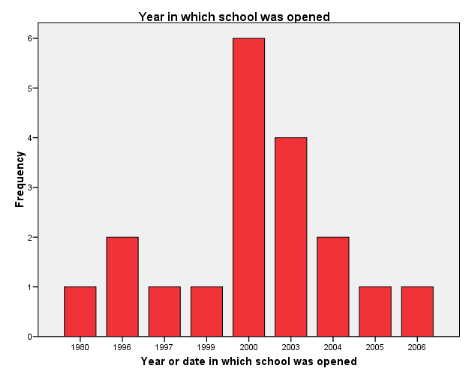
The information contained in the data equally reveals the age
of these schools owners. Out of the 20 schools 19 told us their ages. The
youngest school entrepreneur was aged 30 years old, while the oldest was aged
64 with a mean age of 42 years (table 2).
Table 2: School owner
19
30
64
41.79
10.136
19
Age of school owner
N
Minimum
Maximum
Mean
Std. Deviation
![]()
Figure 2: Age of school
owner
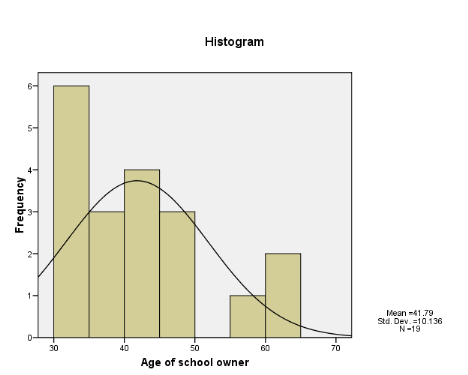
Private schools in the slum of Kibera are owned by various
categories of people. With a limited number of schools involved in the research
(20 schools), the study observed 3 main categories of ownership type. The first
category worth 50% of the schools operating in this area, are community-owned.
This implies that the functioning standards and the school's targets are
decided and implemented by a ruling body with a strong support from the
community essentially made up of local elites and parents association. The
second category is that of individual proprietors (45%). This type of
`ownership' implies that the individual through their own personal initiatives
and funding set up schools and autonomously operate these with or without any
external support. Finally, the third category (only 5%) is made up of
partnership owned schools (see figure3). This last set of ownership type draws
its resources and establishes the basis of its functioning on a joined
initiative, generally with some NGOs (Non Governmental Organisations) or with
another group of entrepreneurs.
Figure 3: School ownership type
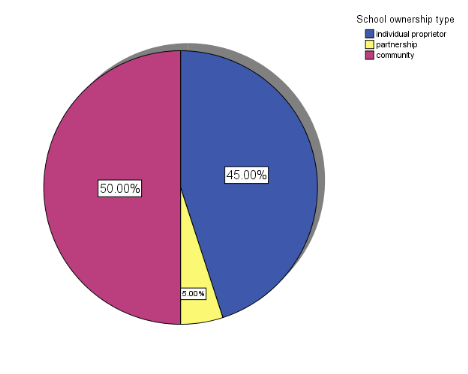
4.2.2 The Slum of Kibera
Kibera is known to be one of the largest informal settlements
in East Africa. The term «slums» typically implies live conditions
that are overcrowded with very little access to basic necessities. Electricity,
sanitation, clean water is simply a mere dream for the bulk of the population
living in this environment. According a recent study in the middle of last year
by Stefano Marras, a mapping specialist, the numerical dimension of Kibera is
set between 2.3 and 2.5 sq kilometres and the total population living in the
slum can be most likely estimated to 220,000 and 250,000 people.
Figure 4: A view o the slum
of Kibera
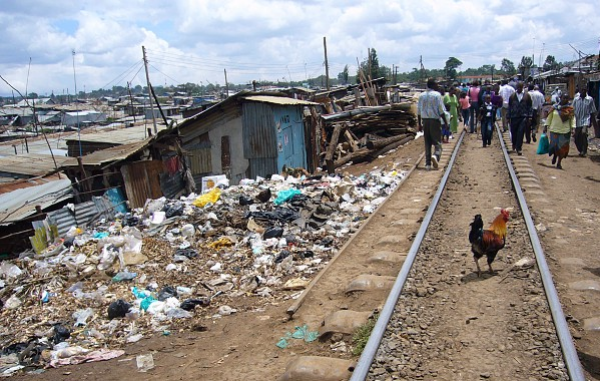
4.2.3 The pupils
When asked why children attended private schools in Kibera
rather than walking to one of the five government schools that are situated on
the periphery it seemed that attending a school that was close to the home was
one priority. The pupils in this research all stated that they
travel to school on foot implying that it is important to them and their
parents to live relatively close to their schools. When asked about their homes
pupils said that they consisted of either a single room or there were a maximum
of two rooms. None of the homes had a kitchen and only three homes had access
to an inside toilet. The number of people living in the family home ranged from
two to 11 with a mean of six people (see figure 5).
Figure 5: Number of adult and children living in the
family home
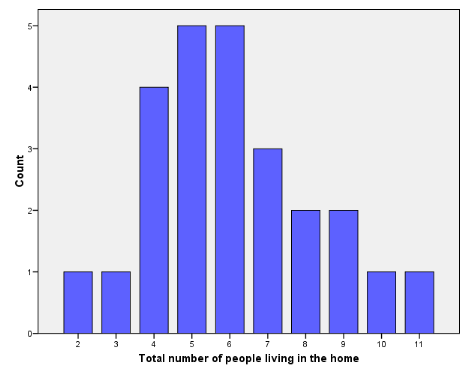
One of the most striking parts of the research brought forward
the fact that in almost all cases, the pupils parents suffered from abject
poverty. When asked if their parents (both father and mother) had a paid job
only three mothers out of the total 25 undertook paid employment. These ranged
from business, cleaner and labourer. The rest of the 22 pupils' mothers are
jobless. Similarly only four of the pupils' fathers undertook paid employment
as labourers, one had died and the remaining 20 have no employment (tables
3&4).
Table 3: Mum has a job

Table 4: Father's job
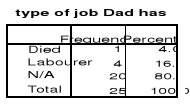
By implication, most parents in the slum do not have the
financial resources that can enable them to address their offspring's
educational needs. So it is important to address how these parents are able to
pay the school fees in order to attend a private school and why they would do
so. At this effect, George Mikwa argued that:
«In the ending 1980s and 1990s the government and
public schools in Kenya used to implement a cost sharing policy for school
enrolments. The amount per pupils mounted sometimes up to £40 and parents,
who in the greater majority are very poor, raise money for the children
education through crops growing and selling, found it extremely costly. Then
many private schools started operating around the community charging lower
fees... Then the government introduced Free Primary Education in 2003... When
something is said to be free in Kenya, you would expect everybody to be there.
The parents realised that the quality has dropped and thought that it was
better to sacrifice and pay some money in private schools so that their
children could get good education.»
4.3 Motivations for Investment in
the field of Education
This section looks at the reasons why entrepreneurs find the
field of education an area of investment and why they are motivated to set up
schools in a poor or low income area. In tracing back the story line of these
young set of new entrepreneurs in Africa, the sub sections that make up this
part carefully throws more light in uncovering their foremost motivations for
investment and henceforth enables us to gather accurate information and general
perception of the prevailing investment climate in the field of education in
Kibera.
4.3.1 Lives within the
community
When asked why the school owners set up schools in Kibera
several issues arose. What seemed to be a major factor was that school owners
lived within Kibera itself. For example, typical of the statements from the
school owners regarding this are the following:
«I have stayed in the area for 15 years and had
discovered the need of starting a school in the area...» (School owner A
(Dagoretti Youth Centre))
And
«I started a school as I am a resident of
Kibera» (School owner B (Future Kids Academy).
This trend is reinforced by the fact that, being part of the
community or having resided in the community for a good number of years, these
entrepreneurs have a mastery of the socio-economic field and are somehow closed
to their target: The population living in the slums.
4.3.2 Inadequate schools in the
area
The second major reason given for setting up a private school
was that the school owners saw a lack of education for the children of Kibera.
Even though the World Bank provided £55 million in 2003 to assist the
introduction of Free Primary Education (FPE) there is still a lack of
government school provision for children from the slum. According to school
owner A:
«We have very few public schools in the area and I was
touched when I used to see idle children in the area» (School Owner
A).
And:
«I set up my private school in order to assist
children from low income families to access schools as there are inadequate
schools in the area.» (School owner J)
In addition to this, a question was asked to pupils involved
in the study. This sets out to find out if they had attended a public school
prior to enrolling into a private one. Out of the 25 pupils, 11 had attended a
public school before joining the private. When asked why they chose a private
school where fees had to be paid rather than a free government school the
overwhelming majority stated that the conditions for learning in the government
school were not suitable enough for them. Some examples of their arguments
are:
«The classes in public school are over populated and
the teachers are not committed because they sometimes don't teach us at
all» (Student 16, school C)
And:
«My class in the public school was very congested and
my teacher never paid attention to what I was doing during lessons or if I was
performing well in the exams. I felt bad about it because I realised that I was
not learning anything.»(Student 25, school E)
These statements seem to reinforce the arguments provided by
the school owners that government schools for the children of Kibera are not
suitable owing to the cramped conditions and the attitude towards children from
the slum. Having a school that one can access in one's own community seems to
be a major reason for private schools to exist.
4.3.3 Focus on orphans, poor and
vulnerable children
Another motivation stated by the school owners for setting up
their schools in Kibera has to do with the empathy and concern for the poorest,
orphans and vulnerable children. They wanted to offer the opportunity to
orphans and vulnerable children who could not afford to be educated in their
institutions. In stressing on the importance of this trend, some of school
owners reported that:
«The area has two developed academies which targets
pupil from relatively rich families who are able to pay the high rates of
school fees they charge. This led us to start up this school to cater for
children who were not able to enrol into public schools and other academies for
one reason or the other. In fact we wanted to give orphans and vulnerable
children the opportunity to have access to education.»(School owner B. St
Stephen Children Centre & school)
And,
«I was so much concerned with the fate of orphans,
destitute and neglected children. As a Christian, I felt so bad when I use to
see them around. I first started teaching them in my house and seeing that the
number was increasing, the community and some members of the church helped me
to set up a school for this particular group of children.» (School owner F
(Support Orphans and Destitute Academy)
These factors are extremely important in understanding the
investment phenomenon taking place in many developing countries. In this case,
the mushrooming of private schools catering for the poor and the needier in the
slum of Kibera is partly attributed to the huge number of less educated
children living in the community.
4.3.4 Profit motive
The school owners that took part
in the research acknowledge charging fees to their pupils for many purposes.
Some of these costs are either allocated for uniforms, text books or
examination fees. Although not every school applies this fee scheme for all the
pupils' expenses, it is however worth noting that all of the 20 schools in this
study charge a registration fee. The monthly fees for children in the research
schools range from £3.97 to £13.49 (see figure 6). These fees are for
many of the school owners, the principal financial income of their schools and
are used in covering the expenses related to the functioning of the business.
The main costs for the school owners are teacher salaries.
Figure 6 Monthly fees
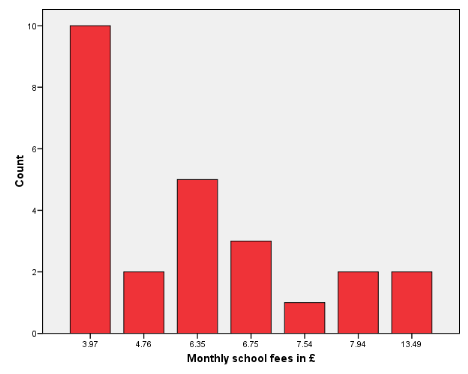
Although it has been noted that all these schools charge fees
on business principles for their effective functioning, our study has brought
forward the fact that, a good number of these schools, if not all of them,
equally offer considerable support in the form of scholarships to the needier
pupils. We specifically laid an emphasis on this issue while setting the
questions to school owners. It was found that close to a relatively high
proportion of the schools do offer scholarship to two categories of pupils.
This form of support accounted for up to 65% of scholarships awarded for
orphans and 25% for outstanding children (tables 5 and 6). Not absolutely
refuting the fact that they make some money out of their investments, many of
the school owners however do emphasise that their investment aimed first and
foremost, at covering the educational needs of the population in which they
themselves live. Offering assistance to such students contribute to make the
awarding institution a valuable one and thus motivate many other pupils and
parents to cast their choice on it for future enrolments. This could be seen as
a marketing policy taking place in a competitive business arena.
Table 5: The school offers
scholarships for orphans

Table 6: The school offers scholarships for
outstanding students

4.3.5 Equity
Equity issues in private schools in Kibera are, according to
our study, taken with the highest level of importance. The fact that the
businesses operate in slums and cater for low income families is to an extent
the sign of their wanting to implicate all categories of people into education.
As the research presents it, Kibera is a large slum with a massive number of
poor children living altogether. The school owners tackle equity issues from
different perspectives allowing those from families where there is no income,
or no parents have access to education alongside those who can afford the fees
and have a more stable family life.
4.3.5.1 Opportunities
The private schools in Kibera play a fundamental role in
filling the gaps created by educational needs in this community due to the
growing number of people. By offering less expensive education to those who can
afford and by allocating special funds in the form of scholarship to a
particular group of pupils as stated earlier, many children of the slum are
given chances to participate in the school systems and do benefit from the
advantages offered by the schools. In addition to this financial support
ranging from £4 to close to £397 in very rare instances (see table
7). School owner A (Dagoretti Youth centre) stresses on some of the important
issues which are applied in his institution in order for all the students to
feel that they are treated equally and comfortable. Among these are:
- A flexible admission criteria for all the students
irrespective of their age and social background;
- A child friendly approach within the daily relationship with
pupils;
- Free extra coaching for slow learners;
- Home visit follow ups for children in the community.
For some other institutions like school G (Mukuni community
centre) school F (Zafarani School) and school I (Future Kids academy), specific
emphasis is being laid on lower and affordable school fees to all as well as
free teaching /learning materials. Other benefits include the teaching of civic
education and free immunization campaigns against some diseases.
Table 7: Orphans' financial support
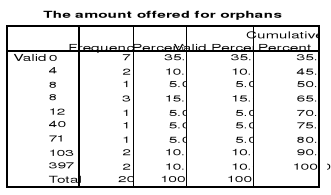
All these factors put together contribute significantly to
alleviating the cost of educational provision in these non formal settings of
Kibera. It equally makes the learning environment attractive to many pupils and
parents who for some reasons feel excluded.
4.3.5.2 Gender
On a similarly important note of equity, is the gender issue.
That is the education of both male and female pupils in equal proportions. The
girl's education in the slums of Kibera is a priority and the private schools
that operate in this environment in their rallying policies do well in
promoting this trend. Even though our study did not particularly looked at this
issue from a separate angle, the statistics for pupils enrolments in the 20
schools that took part in to the study actually show an overall satisfactory
result. Girls' enrolments in private schools in the slum of Kibera for this
academic year substantiate this speculation. From the enrolment statistics of
19 schools out of the 20, girls' enrolment range from minimum of 47 pupils to a
maximum of 560 pupils, with a mean of 205.47 while boys' enrolment ranged from
a minimum of 38 pupils to a maximum of 470 and a mean of 206.42 (see tables
8&9). The following figures and tables illustrate these relative equitable
enrolments for boys and girls in private schools catering for the poor in
Kibera, Kenya. In a nutshell girls are given the same learning opportunities in
the slum.
Figure 7: Number of girls in the 20 schools this
year
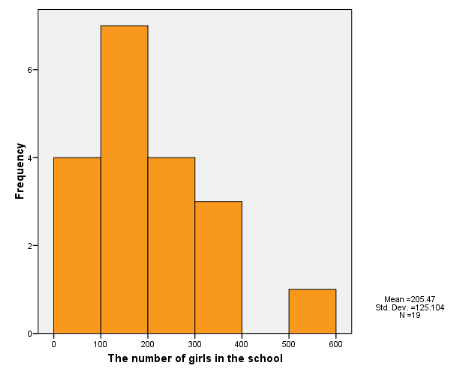
Table 8: Girls in school

Table 9: Boys in
school

Figure 8: The number of boys in the 20
schools
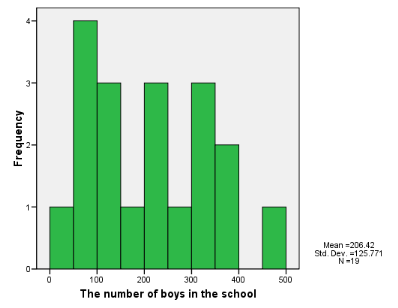
Another important aspect of the gender issue in the private
school provision in Kibera is related to the employability of the staff. The
study in five specific schools reveals that women are equally given high esteem
when it comes to teaching. In fact out of the 25 teachers, 12 were female and
13 male. This fact stresses the equal opportunities scheme that is applied by
the entrepreneurs while recruiting staff into their institutions.
Figure 9 Teachers'
gender
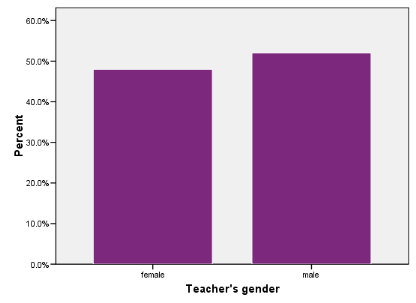
4.3.6 Regulations of private
schools in Kenya
This part of our research sets out to critically analyse the
regulatory climate in the private educational sector in Kenya as well as
finding out if at all, the prevailing environment is indeed conducive for
effective investment. The first impression that came out after a series of
questions with the school owners is that, effective regulatory guidelines for
investors seem to be flawed or simply non-existent. In the absence of such
vital information, it would be difficult to assess the level of government
willingness to promote and expand private investment especially in the field of
education.
When we asked the school owners what were the basic
requirements needed to open a private school in Kenya, they mentioned the
following:
- Registration certificate from the Ministry of Education;
- Lease agreement of land plus buildings( any number);
- Land;
- Basic school equipment/furniture;
- Qualified administrative and teaching staff.
The school owners acknowledge that it may not be easy to meet
up with all these requirements. This is due to fact that they are financially
limited and do not have access to funds that can help fulfil all the
requirements.
Surprisingly enough, the school entrepreneurs seem to be quite
happy with the regulatory climate. Many reasons substantiate their convictions
and satisfactions on the issue. 19 school owners out of the 20 gave a straight
forward answer stating that the regulatory climate is quite conducive for
investment in the field of education. We went forward in asking some of them
their reasons for an overall satisfaction over the regulation of the private
education system in Kibera. The answers were both informative and
encouraging:
«The regulatory climate is very conducive because
Kenyans however poor they are, take education as a priority. Kenya is a third
world country where many people are still striving to catch up with new
technologies, globalisation issues, different life styles and we believe
therefore that education is the key area to driving these. Many Kenyans want to
move out of poverty through education. Indeed Kenya is conducive for investment
in education because the population is growing at high rate and therefore,
there is a need for all these children to be educated.» (School Owner O,
the Amaf schools)
And on a quite different perspective,
«The regulatory climate for private schools
in Kenya is quite conducive. For ages now, many parents have opted for private
education. The public schools are offering sub-standard quality due to free
education. Private schools are on their own well managed with quality
curriculum activities.» (School owner I (Future Kids Academy)
These points of view, somehow denotes that the school owners
understand very little what is meant by regulatory climate. Though having the
merit of throwing a light in what the prevailing regulatory climate would
likely be in Kenya, this opinion is not shared by all the school owners. The
assertion that the climate is conducive enough for investment is
disproportionately adopted. In fact, a more sceptical school owner K (Rofra
Academy) goes beyond this fact to conclude that:
«There is no concrete
policy to regulate the non public sector»
By implication, this means that
concerning the basic requirements for setting up a private school in Kibera,
nothing seem to emerge clearly on what has to be done or what the guidelines in
the regulations state. It would seem more likely that the private schools do
not abide by any regulations, operating in an `illegal' settlement anyway. If
school inspectors do find or arrive at the school it would seem safe to suggest
that bribes change hands or the Association deals with such issues.
In any case, our study has shown
that to a great extent, the entrepreneurs feel satisfy with the investment
climate that exists in Kenya in general and in the slum of Kibera in
particular. Such a climate would seem to be favourable to stimulate
competition, innovation, effectiveness and efficiency between those
entrepreneurs running schools. This would seem to be the case owning to the
large number of schools operating as well as the choice and accountability
provided to the parents because of the large numbers of schools. A situation
like that does offer many alternatives for increasing the socio economic
segments of the population that make up the slum of Kibera.
4.4 Have these schools
suffered from the government's introduction of 'Free Primary Education (2003)'
in terms of enrolment?
This section seeks to investigate the impact that Free Primary
Education has had on the enrolment of pupils in private schools of Kibera since
2003. Free Primary Education (FPE) was introduced in Kenya in the year 2003 by
the Government aided by International development partners. This initiative was
fulfilled by the government as part of the NARC's (National Rainbow Coalition)
election pledge in the general campaign of the year 2002. It set to abolish
fees and levies in the cost of basic education and to offer greater opportunity
to the population to have access to free educational training.
As part of this research, it was decided to carry out an
investigation on the enrolment number of pupils in the private schools before
and after 2003. The results show that many schools in Kibera are growing
increasingly in terms of pupils' enrolments. Some of these schools like
Dagoretti (school A) started in 1999 with a total of 45 pupils and this were
able to enrol up to 500 pupils. Another typical example is the Amaf School
started their activities in 2003, the year of the introduction of FPE with a
total of 15 pupils and which for this academic year have enrolled 600
pupils.
The general view as the figures below present is that the
private schools in the slum of Kibera seem to be doing relatively well in terms
of their pupil numbers despite the huge national campaign for Free Primary
Education. Therefore even though there is `free' government education on the
outskirts of Kibera, parents still choose to pay fees in private school.
Therefore if there is a rejection of the government system this needs to be
investigated. There
seem to be several reasons for this highlighted by this
research. As stated earlier, the 11 pupils out of the 25 in our research who
declared have been in public schools before attribute this failure to meet its
objectives by many factors. The quality of teaching, teacher's attention, and
congestion in the classrooms are for instance some of the key arguments that
brought back these pupils to the private schools in Kibera. To sum up, it would
seem that this research shows that even after the introduction of free primary
education in 2003 some parents still prefer to pay to send their children to
private schools. On the contrary, the figures from this study show an increase
in pupils' enrolments after the year 2003. In fact, one could assume that the
private educational system in Kibera is playing a leading role in providing
education to the population despite charging fees. Their cost however is very
limited and extremely competitive if compared to the cost that are charged for
uniforms, books, parents association and many others in government schools,
supposedly free.
Figure 10: First year
Enrolment
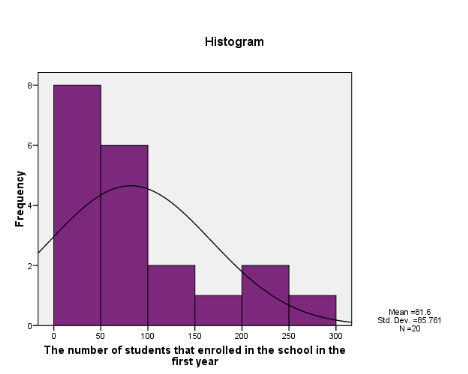
Figure 11: Current enrolments
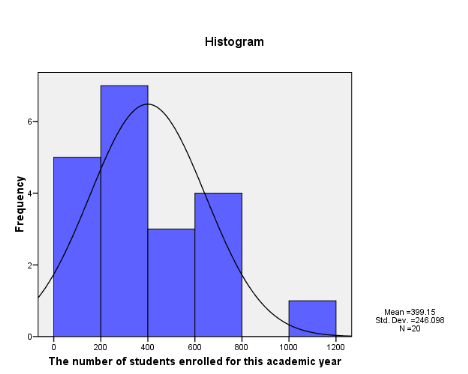
4.5What is the satisfaction level
of entrepreneur's investments as perceived by pupils and teachers?
One of the most important issues arising in any competitive
business is the satisfaction level expressed by the recipients of a given
product. Back to the field of education, all the people who part- take to the
functioning of the business, the investor himself excluded, are the target
people that can make a fundamental assessment of this satisfaction. For scale
purposes we had chosen to gather data from the pupils who are the direct target
audience for which the product is designed and delivered and the teachers whom
the investors use in selling the product to the latter. The findings will
therefore help to ascertain what is most appreciated and what is less desirable
from pupils and teachers points of view.
4.5.1 Pupil Satisfaction
The study used a sample of 25 pupils for testing the
satisfaction level, thus 5 students from five different private schools in
Kibera. Questions ranging from their satisfaction level on several issues were
asked to these children. Henceforth, the satisfaction questions included:
- The rate of their teacher's ability in their respective
subjects
- Teachers' punctuality for lessons
- Teachers' attendance at school
- Teachers attention/ fairness to students
- The rating of English lessons
- The discipline at the school
- The rating for extra curricula activities
- The state of the schools' buildings
- The school facilities (toilets, library, drinking water,
chairs, blackboard etc...)
We equally set to analyse the pupils' tests score on English,
Mathematics and Kiswahili, the local language. The information contained in the
test scores were used to make a correlation between the level of satisfaction
and the level of achievement in their respective institutions.
13 pupils out of 25 said the teachers' ability in their
subject was excellent and 12 said it was good. In addressing the teachers'
punctuality for lessons, 16 said it was excellent while 9 said it was good.
Teachers' attendance rate at school got a positive feedback as 20 pupils
thought it was excellent and 5 said it was rather good. Concerning their
fairness for students, 18 opted for an excellent point of view while 7 said it
was good.
Rating the physical aspect of their respective schools, 12
pupils said the school buildings were good, on the other side, 9 of their peer
thought the buildings are poor and 4 stated that they are very poor. Finally
the school facilities were diversely appreciated by these pupils. In fact 15
said the facilities were good, while 6 of them argued that they were poor and 4
said they were very poor.
From a general perspective, the pupils expressed their
overwhelming satisfaction over most of the issues as the figures displayed
below present. According to these pupils, the teachers in private schools in
Kibera are very committed to teaching them. The teachers all possess a mastery
of subject matter, are very punctual for their lessons and treat their students
fairly this to the greatest satisfaction of the pupils. However two negative
responses emerged from their opinions. These same students gave various
appreciations while rating their respective school buildings and facilities.
Though few students think the infrastructures and facilities are good, others
rate these as «poor» or «very poor» for the rest .
Although no standardised test was set for the purpose of this
research, the pupils' test scores in three subjects were gathered from the
school authorities portray an overall good performance in English, Mathematics,
and Kiswahili .The highest score for the 12 pupils who rated their English
lessons as good is 70/100 while this same score is 90/100 for the 10 pupils who
rated the same lesson as Excellent (see figure 18).The pupils were asked to
rate their own level of Maths. 7 of them said their level was excellent, 10
said it was good, and 5 said it was poor. The correlation of these ratings with
their tests scores however reveals that student 13 of Future Kids Academy who
actually thought his level of Maths was excellent seem to be doing very bad. On
the contrary of student 23 of River of Life Primary school, whose results shows
that he is actually doing well on the subject while he thought his performance
was rather poor (see figure 19).Out of the five sample schools were these
scores were collected, the Amaf school has the best performance on English test
scores while St Christine has the lowest performance. Student 6 of St Michael
particularly distinguishes himself as he emerges as one of the best of his
school on this subject while the overall scores in his school are relatively
good (See figure 20). On Kiswahili, the local language, that Amaf schools once
more emerge with the best test scores comprised between 90/100 and above. Again
here St Christine's performance is the lowest from a general point of view (see
figure 21).
This information is to attest that in spite of the poor state
of the schools buildings, the inner environment seems to be conducive for
effective learning/teaching to take place. At the end of the day, apart from
the perpetual complaints of school buildings and facilities, (which we must
admit is common to most under developed countries educational systems private
or public) it is safe to conclude that to an extent, the pupils attending
private schools in Kibera are satisfied with the entrepreneurs' investments.
Figure 12 - The Rating of the Class teacher's ability
in their subject
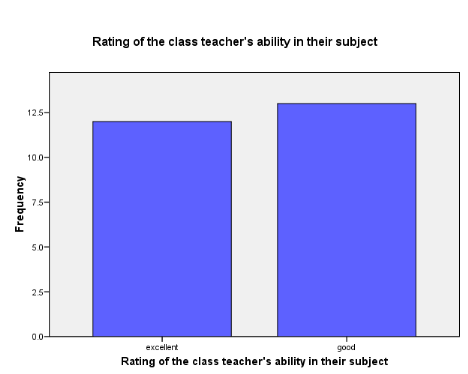
Figure 13 - The rating of the teacher's punctuality
for lessons
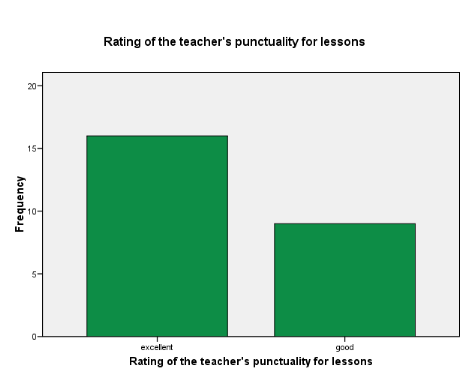
Figure 14 - The rating of the teacher's attendance at
school
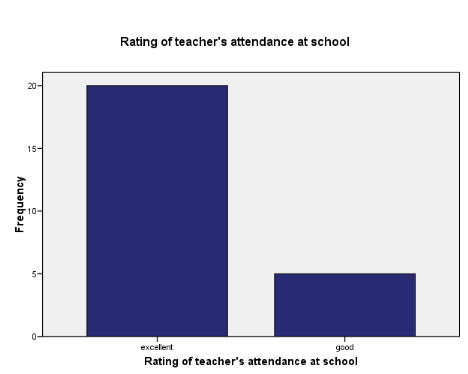
Figure 15: Teachers' fairness for students
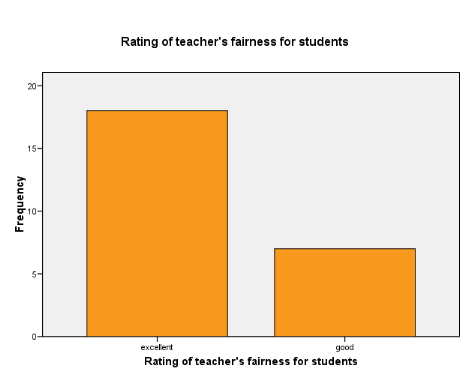
Figure 16 - The Rating of the school
buildings
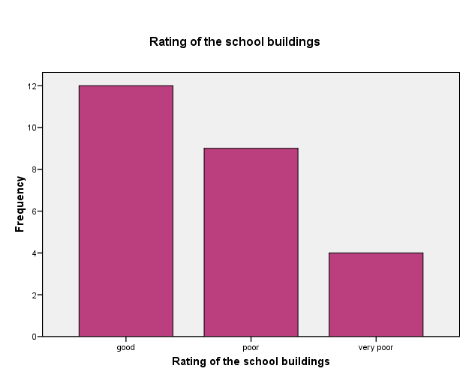
Figure 17- Rating of the
school facilities
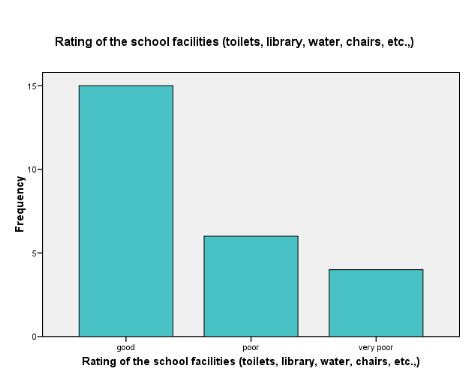
Figure 18 - Rating of English lessons correlated with
English scores
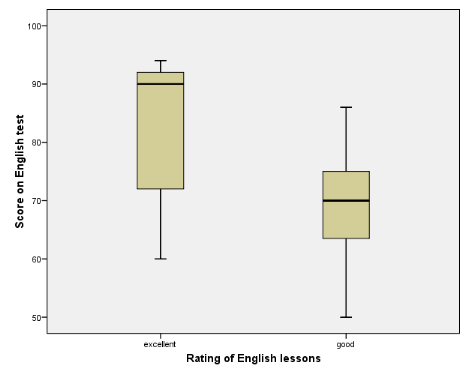
Figure 19- Rating of maths and maths
scores
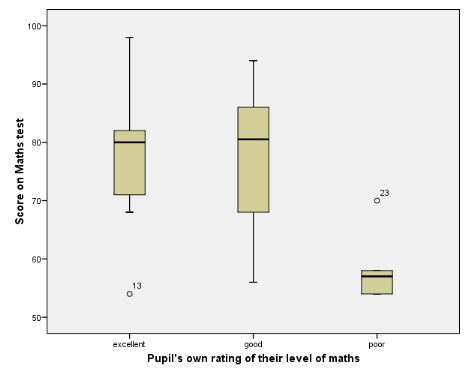
Figure 20 - English results by school
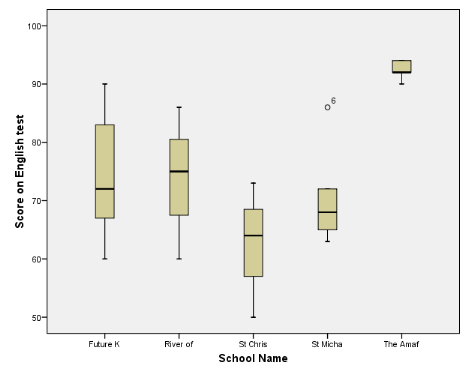
Figure 21 - Kiswahili means plot by
school
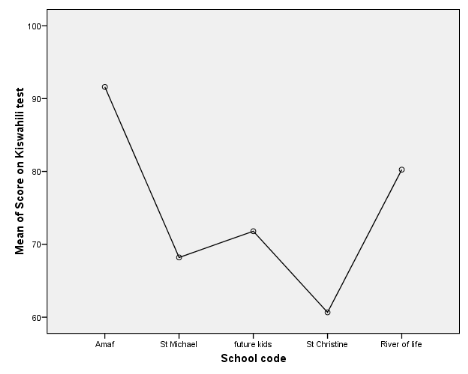
4.5.2 Teacher satisfaction
Considered the linking point between the investors and the
target audience (pupils), teachers in the educational field play an important
role in the process of delivering what could be described as the `product' that
is the teaching and learning. As such, an analysis of the teacher's own
observations of the investment was deemed necessary. In order to assess
teachers' satisfaction, questionnaires were sent to 25 teachers of 5 private
schools in Kibera. The questions sought to find out if they were happy with
their working environments with regards to different aspects. The 12 female and
13 male teachers' age of the five schools ranged between 21 years old and 41
years old, with a mean of 28 yrs and a standard deviation of 6 yrs. (See table
and Figure 22)
Table 10:Teacher's
age

Figure 22: Teachers' age
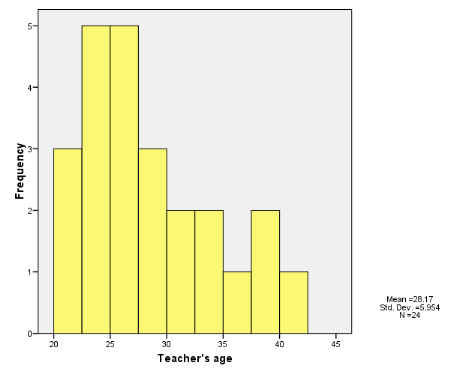
The study equally presents a valuable point related to the
teachers of private schools in Kibera: The qualifications or better still their
highest education level. Of the 25 teachers in the 5 schools, 7 of them have
attained the secondary school level (school up to age 16-18), while 14 have a
college certificate and 4 of them have a diploma.(see table 11). These two
factors (Teachers' age and qualifications) are a determinant factor in
assessing their satisfaction level. The following development addresses this
issue.
Table 11: Teachers'
educational level
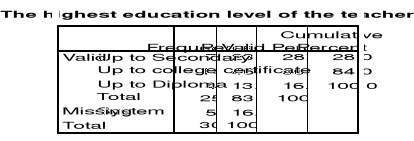
In understanding the degree of their satisfaction, we
set to scrutinize their respective opinions towards certain issues, the main
important consisting of:
Teacher salaries
Only 3 teachers out of 25 reported to be satisfied with their
salaries while 13 said they were dissatisfied and the remaining 9 very
dissatisfied. Their average monthly salaries ranged from a minimum wage of
£28 to a maximum of £95, thus a mean of 53.94 and a standard
deviation 19.921(see table 12). Most importantly the average monthly amount
earned by teachers differs from one another depending of their highest
educational level. The teachers' whose highest education level is up to
secondary school earn less money than their colleagues whose highest education
level is up to a diploma (see figure 24).
Figure 23: salaries' satisfaction
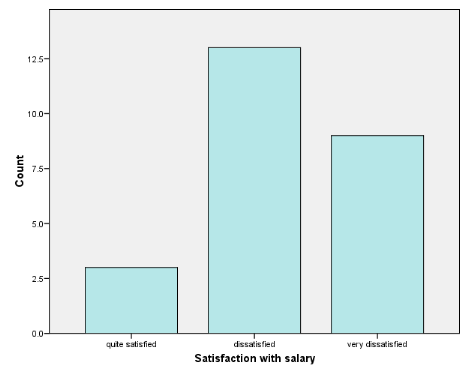
Table 12: Teachers'
salaries

Figure 24: Teachers' salaries
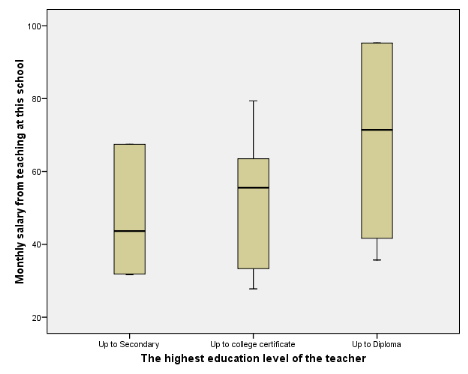
The study equally found that in most schools, the agreed
amount of salary was not paid to teachers on a regular basis. This is
considered in serious handicap in the teachers' motivations as more than 40%
teachers said this was one of their first important problems with private
schools in Kibera (see figure 25).
Figure 25: Irregular salary
payments.
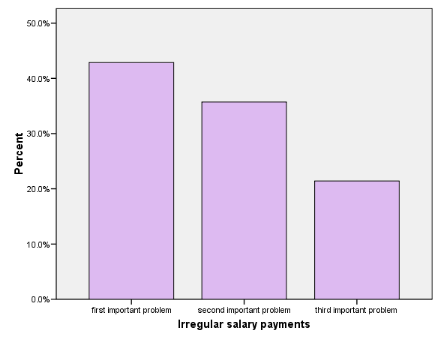
Amount of leave or holidays
Over 96% of the teachers expressed that they were satisfied
with the amount of leave that is granted to them in their schools and just
1teacher out of 25 declared being dissatisfied. This is quite valuable
information for the teachers in Kibera. The holidays or leave period offer an
opportunity to focus on something else not related to teaching and thus prove
to be revitalising in terms of energy.
Figure 26: Holidays' satisfaction rate
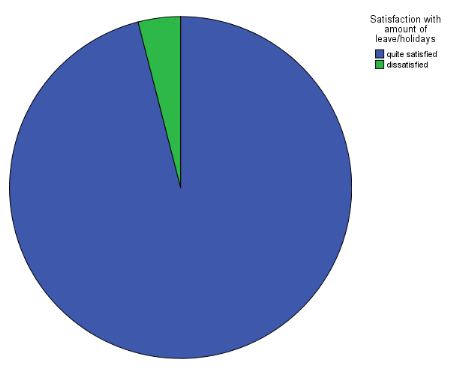
Teacher's social status in the community
The status in the community in many developing countries is an
important aspect which determines the incentive for joining the teaching
profession by many youngsters. For the case of teachers of private schools in
the slum of Kibera, 1 out of 25 felt «very satisfied» with his social
status, while 19 reveal they are «quite satisfied» and 5 expressed a
negative point of view concerning the issue (see table 13)
Table 13: Social status in
the community
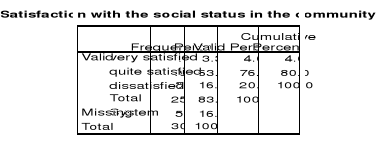
The work environment
The term work environment means the cooperation ties that
prevail on one hand between the teachers and the school administration and on
the other, between the teachers and the pupils both in class and in the
community. At this effect, our study found that there was a divergence of
opinions. 1 teacher out of 25 said they were satisfied with the working
environment, while 11 said they were quite satisfied. On the negative side of
the group 10 teachers declared being dissatisfied and finally 3 of them
reported as being very dissatisfied.(See figure 27)
Figure 27: Satisfaction with the work
environment
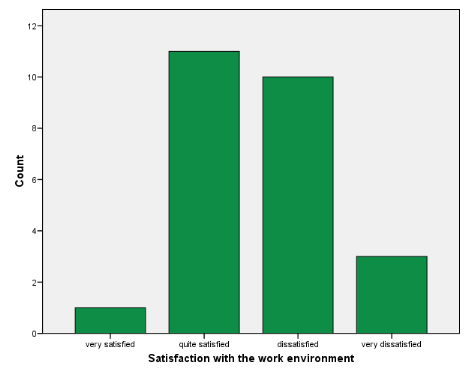
The facilities (books, teaching aids etc)
The facilities offered to teachers play an invaluable role in
the knowledge transmission process. Without these, the act of teaching would
simply be more difficult especially when dealing with children from poor homes
whose parents cannot afford all the learning materials. As the figure below
presents it, a vast majority of teachers (17) do not value the facilities that
are put at their disposal. They feel dissatisfied with the overall facilities
in their schools. The remaining teachers are divided into three categories: 1
teacher says he is very satisfied with the facilities, 5 are quite satisfied
and finally 2 teachers are very dissatisfied (see figure 28).
Figure 28: Satisfaction with facilities
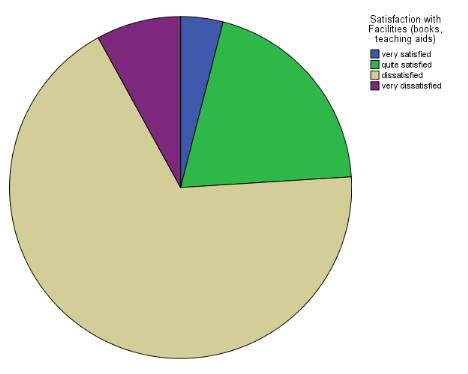
The infrastructure (furniture, buildings etc)
Concerning the school buildings, an unprecedented number of
teachers expressed their dissatisfaction. Like it was the case with pupils, the
teachers in a great majority think their school infrastructures including the
buildings and the furniture are very poor. 2 teachers said they were either
very satisfied or satisfied, while 14 said they were dissatisfied and finally,
9 out of the 25 said they were very dissatisfied.
Figure 29: Satisfaction with the school
infrastructure
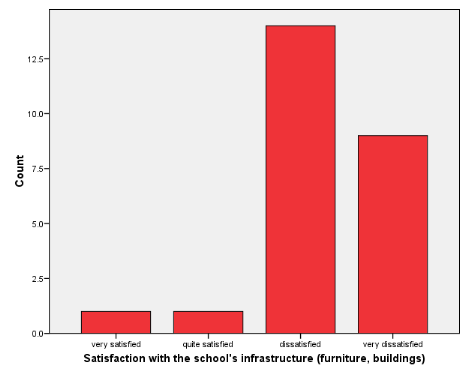
Finally, a question was asked to the teachers requesting them
to rank in the order of importance, what they thought were the crucial problems
they face as teachers in the slum of Kibera. Three major points emerged from
this question. 19 teachers reported that poor infrastructures was their first
and most important problem follow by lack of facilities which 17 teachers said
was of second importance and finally, a number of 14 teachers mentioned
irregular salaries as the third problem.
It would seem that teachers' satisfaction in private school
investment in Kibera (taking this to be infrastructure etc) varies from one
teacher to the other. However, our study has shown that the satisfaction of
teachers in Kibera is quite difficult to assess from an individual points of
view. The general trend that could be noted here is that in a great majority of
cases the teachers believe that issues regarding their salaries, the
infrastructures and the buildings in private schools of Kibera need to be
addressed.
Table 14: First important
problem
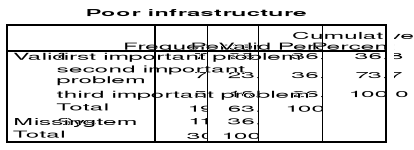
Table 15: Second important
problem
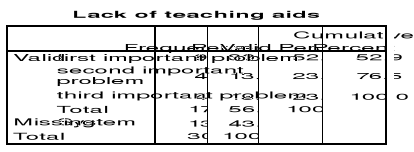
Table 16: Third important
problem
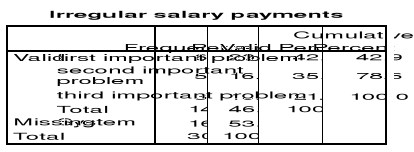
4.6 Factors identified as the
major gaps in private provision
Having scrutinised various aspects of private school
investments in Kibera, we have come to realise that the actions undertaken by
this type of entrepreneurs in the provision of education in the slums is highly
appreciated by the populations. A typical proof to this fact would be the
number of pupils enrolled in the schools. Private schools in Kibera have had
the merit of bringing the educational setting close to its people thus
resolving the tremendous problem of travelling distance faced by people in
developing countries.
It has equally been revealed that, even though the Kenyan
government introduced Free Primary Education in the year 2003, the private
schools in the slum have not suffered from a deficit in their enrolments;
instead the figures available for this research have noted an increasing number
of pupils enrolling in non formal education after 2003. This, as presented
above, is due to the fact that Kibera is one of the most populated slums in
East Africa, and therefore needs enough educational institutions to get the
children educated, an action which cannot be left alone to the government. In a
more specific term, the parents and pupils of Kibera seem to have set their
heart on the private educational sector, which according to them, does deliver
education of quality with teachers paying special attention to pupils evolution
both at school and in the community, unlike in the public sector where classes
are overcrowded.
However, our study, though of a very small scale has noticed
some shortcomings in this form of provision. The interviews that were
distributed to pupils and teachers, the main recipients of the business
initiative, provided us with several shortcomings:
- The private schools in Kibera are not regulated. The flawed
nature of this aspect of the business would always lead to a difficult climate
for investors and for the recipients. In order to render the business more
competitive and profitable to all and especially the needy, there is a need to
reassess the regulatory principles governing private school investments. To
this effect, the authority power of the KISA could play a greater role here if
the regulation of non formal schools in Kibera was entrusted to them. They
would certainly contribute to a better harmonisation and a follow up of private
schools standards.
- The private schools in Kibera suffer from the absence of
buildings , infrastructures, facilities, teaching and learning material, just
to name a few.
The absences of the latter which is in the opinion of many
critics, a serious handicap in enhancing teaching/learning in an area such as
Kibera and in generally in all developing countries. However, considering the
community itself is extremely poor, the states of the schools are likely to
reflect those of its houses and buildings. It would actually be difficult for
an entrepreneur to invest in modern school buildings while his sole budget is
derived from pupils' fees. After all, the general trend portrays a satisfaction
of parents and children in learning priorities and costs offered by these same
schools.
- Finally there is need to critically address financial issues
in this form of provision. Our study revealed that almost all the schools
incomes were drawn from school fees paid by pupils. Finance seem to be key
problem in third world entrepreneurship as there a few financial resources
available for investors who nurture the desire to run a business of their
own.
Apart from these few points, the general consensus of both
pupils and teachers is that they are quite satisfied by investment initiatives
of the school entrepreneurs in Kibera.
Chapter Five - Conclusion, Summary and the Way Forward
At the end of our study centred on primary education and
entrepreneurship in East Africa, a number of information and reflection have
emerged from the case study of Kibera concerning the contributions of the
private educational entrepreneurs in combating illiteracy and boosting the
United Nations campaign of Universal Primary Education (UPE). The high demand
for private schools provision and the mushrooming of independent schools
catering for the poor in Kibera as well as in other countries in Africa have
been noted in the course of this study. Further, some impressions have equally
been drawn from the actions undertaken by educational entrepreneurs in Kenya in
the perspective of improving the quality of their schools.
This chapter sets out to discuss our study findings and their
relation to existing literature so as to be able to determine if they answer
all the research questions. From there on, suggestions and implications will be
developed so that education in Africa in general and Entrepreneurship can
evolve positively and contribute efficiently to the development process of the
continent. The research has revealed the overwhelming existence of many private
schools catering for low income families across Africa. Whether in Ghana,
Nigeria, or Kenya, it has been noted that the greater majority of parents
living in slums and remote areas give more credit to private schools, this
taking into account the number of enrolments in these settings.
In Kibera where we set out to focus the study, our findings
clearly states the key role played by educational entrepreneurs in the general
process of offering quality educational provision at affordable costs to the
entire population living together in the slum. From a critical stand point, we
were amazed to notice that a good number of these entrepreneurs live in the
communities in which they have set their schools (see Tooley and Dixon 2005)
and it denotes that these entrepreneurs generally individuals with backgrounds
in education; do have at heart the education of the children of the development
of their respective communities. It was found that the schools owners have
either been trained as teachers in the government for some time or simply have
been teaching in private schools for a good number of years prior to
establishing their own schools. Having such a background can only be of
greatest importance in a project like providing education to the mass.
Questioning their motivations for investments in the field of
education, the general view point which emerged was the fact that the overall
quality level of education in the public sector was left to be desired with
overcrowded classrooms and absence of professional conscience from its
teachers. The entrepreneurs did mention that there were no adequate government
schools in their localities. Being themselves parents, they felt the utmost
desire to provide their offspring with quality education at affordable cost.
Their investments were equally geared towards bringing the school settings
close to the pupils and henceforth solving the problems of long distance
schools (see Tooley and Dixon 2006). Another striking reason was the peculiar
attention given to socially excluded children, vulnerable children and the
poorest. The research revealed that considerable amount of money in forms of
scholarship and financial assistance was allocated in most schools to orphans
and the brightest children. Equally on a more specific side, the school owners
made sure that the standards and quality of their schools remained very
positive, this in the perspective to secure the loyalty of their pupils and
attract more students in a long run given the highly competitive environment in
which they operate.
By investing in such an important sector of a country's life,
the entrepreneurs do not only think of the financial outcomes as it is claimed
by some critics (see Lewin 2007, Rose 2006).Indeed they charge school fees to
pupils and this is somehow the only source of their funding. The private
schools in Kibera rely solely on the contributions derived from students'
tuition to run effectively. However parents and community members apparently do
not find any problem with the charges in the private sector provided they are
satisfied with the children progress.
Looking at the question related to regulatory issues and
investment climate in Kenya, the study came out with no specific guidelines
regarding it. Based on the answers that were given by school entrepreneurs, we
assumed that effective regulatory guidelines for investors seem to be flawed or
simply nonexistent. In such an instance, it would be quite difficult to assess
government willingness to expand and promote private investment. However we
noted that the private school owners were quite pleased with the situation
considering the huge number of private schools existing in the slum.
The Free Primary Education campaign launched in Kenya in the
year 2003 has not ha d a major impact on pupils enrolments in private schools,
our study reveals. Earlier before the initiative, private schools in Kenya
already existed and years after it, many pupils still attend private schools.
From the responses gathered through questionnaires, it has been noted an
increasing number of enrolments in private schools of Kibera after the year
2003.Some pupils equally mentioned that prior to enrolling in private schools;
they had earlier attended government schools and were not satisfied with the
overall system in spite of the fact that it was supposedly free. Hence, the
private schools for the poor in Kibera can still claim leadership over the
government schools in terms of provision thanks the importance which is being
attached to quality education in these settings. The state might be the sole
responsible for making the reality of the delivering of universal right of
primary education to the poor of Kibera and Africa as it is claimed by
Lewin(2007), however our research shows that this assertion is not generally
accepted by the population concerned. They actually know what is good for
them.
Measuring the satisfaction level of these investments as
perceived both by pupils and teachers, the general trend that emerged is the
overall contentment with the functioning system of private schools in Kibera.
Pupils said to be happy with their teachers' ability in their respective
subject. The degree of teacher's involvement in private schools is likely to
out pass that of their colleagues in government schools. This same phenomenon
was revealed earlier by Tooley and Dixon with the case of their study in India
were they found that there was a feverish classroom activity going on in
private schools were they called unannounced.
Teachers in private schools in Kibera as it is likely the case
in other countries are very punctual and always present in schools and in
addition, they pay extra attention to their pupils, treating them fairly and
all this in a very disciplined environment. The reason behind all the qualities
observed with teachers here may be related to the scarcity of job opportunities
in developing countries especially in remote areas. The prevailing competitive
environment warrants the teachers to take their duty seriously if they want to
be kept by the school administration and the community. However nearly all the
pupils taking part to this research admitted their disappointment concerning
the schools infrastructures but did not stress so much on it as what matter the
most for these pupils was the knowledge that they were able to gain from such
dilapidated structures.
On their own, teachers expressed relative satisfaction with
their working environment, the number of days allocated for leave of holidays
within the academic year and their social status in the community. From a
general point of view, what constitutes the major handicap for almost all the
teachers in this slum is the amount of money they perceive in form of wage. In
fact just three teachers out of the 25 that formed the basis of our research
said to be satisfied with their salaries and in some cases the agreed amount of
salaries were not paid on regular basis thus putting the teachers sometimes in
extremely difficult situations. Rating in order of importance what teachers
felt was a real handicap in private schools of Kibera; they mentioned firstly
the poor infrastructures, followed by a lack of teaching aid including books
and teaching aids, and finally irregular salary payments.
The assessment which was done in this research through
questionnaires and interviews did not only depict a positive picture of private
investment in Kibera. Indeed the amount of population living together in slum
need enough educational institutions to ensure that the level of illiteracy
gradually reduce, something which the government cannot claim to be able to do
all alone. «The heart of the population of Kibera and other poor areas in
Africa seem to be beating for private schools» and for this reason several
points need to be reconsidered in order to render the quality of these schools
of better standard. The commendable efforts deployed by the Kenyan Independent
Schools Association (KISA) need to be revitalized through general, technical
and logistic support. There is no doubt that the private sector in Kenya and we
presume elsewhere in Africa too, is a key determinant factor in the global
vision of expanding primary education.
Further while elaborating policies on Universal Primary
Education, it would be wise enough for state leaders, educational
stakeholders, international organisation, national and multilateral agencies to
consider and involve private schools entrepreneurs' ideas in the general
consensus for a better appraisal of the sets goals. Refuting the role played
of the private sector in the millennium campaign for Universal Primary
Education as advocated by many critics (Watkins, Lewin, Rose) thus give the
false impression that nothing is happening on the continent as far the
development of education is concerned.
Inextricably, the various factors which could be identified
as the major gap in the private provision of education in Kibera in our
research converged to the same conclusions by Tooley and Dixon: The private
schools in Kibera are not regulated, they suffer from the absence of buildings
and infrastructures and lastly they all face striking financial
difficulties.
These three aspects could be ameliorated if the private
schools in Africa were given the least of attention and interest from the above
mentioned institutions and partners.
Finally, it is suggested that in the perspective of boosting
Entrepreneurship in Africa especially in the field of education, a study of the
regulation of private schools in Africa should be carried. Ayittey (2007)
stated the importance of the investment environment in the developmental
process of Africa. An environment which, according to him is shaped by various
government legislations, policies (taxes, duties, and subsidies), institutions
and attitudes. In a case where this environment is such that it fosters
peoples' effort, it becomes a catalyst for development. Such an environment is
described as «enabling» or «conducive» to productive
effort. (Ayittey 2007:159)
The study of the regulation of private schools for low-income
families in Andhra Pradesh, India undertaken by Dr Dixon in 2003 has been of
tremendous help in the understanding and the development of this sector in
India. By carrying such a similar study in Africa, it would enable a better
appraisal of the private educational sector and shall henceforth establish the
basis for future support educational entrepreneurs of Africa.
Finally, it is equally felt that associations such as the
Kenyan Independent schools Association (KISA) are better placed to act as a
regulatory board for all the private schools operating within their sphere of
competency. Considering their familiarity and their expertise with the sector,
they could actively foster the development of private schools in terms of
quality if they were given just half of the support that is being given to
government schools.
From the foregoing analysis we can assume with little fear of
contradiction that the contribution of private schools entrepreneurs in East
Africa in the overall campaign for Universal Primary Education is commendable
and worthy of support. Be it in Kibera (Kenya), in Makoko (Nigeria) or in
Mbouda (Cameroon), private schools do play acting roles in educating the
increasing number of people and they much more preferred by the population than
the government schools even in a context of Free Primary Education(FPE) across
states of Africa.
Our wish is to see that this research continues it course for
a better understanding of the private educational sector and its contribution
to the development of Africa in general.
Bibliography
1. Ayitteh, G. (1992) Africa Betrayed, CATO, St Martin's
Press, New York. Chapter Five, pp.97-114
2. Ayitteh, G.(2005) Africa Unchained: The Blueprint for Africa's
future, Palgrave, Macmillan,pp 155-171
3. Ayitteh, G. (2007) The African Development Conundrum, in
ed. Powell, B. (2007) Making Poor Nations Rich: Entrepreneurship and Process of
Economic Development, The Independent Institute, Stanford. Chapter 6 pages
138-186
4. Backiny-Yetna and Wodon (2009).Comparing the Private cost
of Education at Public, Private, and Faith-Based Schools in Cameroon. World
Bank
5. Bell, J. (2005) Doing your research project- A guide for
first-time researchers in education, health and social science, fourth edition.
Open University Press
6. Best, J. Kahn, J (2003) Research In Education .Ninth
Edition, Pearson Education Inc.
7. BERA (2004), Revised Ethical Guidelines for Educational
Research (2004)
8. Boettke,P.(2007)Entrepreneurial Responses to Poverty: The
Enterprise Africa Project,IEA,London.
9. Bryman, A. (2006) `Paradigm peace and the implications for
quality', International Journal of Social Research Methodology,Vol. 9 No. 2,
pp.111-126
10. Chimombo, Joseph, P.G, 2005, Issues in Basic Education in
Developing Countries: An Exploration of Policy Options for Improved Delivery.
Journal of International Cooperation in Education. 8(1), 129-152.
11. Cramer, D (2003) Advance Quantitative Data Analysis (Eds)
Open University Press.Maidenhead.Philadelphia
12. Creswell, J (2002). Research Design: Qualitative,
Quantitative and Mixed approaches. (Eds) Second edition. SAGE; 2002.
13. Denscombe, M(1998) The good research guide for small-
scale social research Projects. Buckingham: Open University Press.
14. Department for International Development, 2001. The challenge
of universal primary education. London: DFID.
15. Dixon, P (2003) The Regulation of private Schools in Low
Income Families in Andhra Pradesh, India: An Austrian Economic Approach. PhD
Thesis, Newcastle University.
16. Dixon, P. (2009) Private Schools for the Poor in Kibera -
An Update, Working Document, unpublished.
17. Easterly,W.(2006) The White Man's Burden: Why The West's
Efforts to Aid The Rest Have Done So Much Ill and So Little Good, The Penguin
Press, New York.
18. Easterly, W.(2008) Ed. Reinventing Foreign Aid, The MIT
Press, Massachusetts and London.
19. Elkan,W.(1988) Entrepreneurs and Entrepreneurship in
Africa, The World Bank, Washington DC.
20. Einsenhardt, K.(1989) Building Theories from Case Study
Research. Academy of Management review, 1989, Vol.14, N° 4, 532-550
21. Flyvbjerg, B (2006) Five Misunderstandings About Case
-Study Research. Qualitative Inquiry. Sage Publications. Vol. 12, N° 2,
219-245.
22. Fogelman, K &Comber (2007) Surveys and Sampling, in:
Briggs, A &Coleman (Eds) Research Methods in Educational Leadership and
Management, 2nd Edition. SAGE Publications
23. Karmokolias, Y.Maas, L et al. (1997) The Business of
Education A Look at Kenya's Private Education Sector. IFC Discussion Paper.
Num32. [S.l.], Distributed by ERIC Clearinghouse
24. Kitaev, I. 2004, EFA and Private Education: Some Regional
Experiences and Findings. Journal of The Institute of Economic Affairs, 24(4),
27-31.
25. Kitaev, I (2007) Education for All and Private Education
in Developing and Transitional Countries, in: Walford,G & Srivastava,P
(2007) (Eds) Private schooling in developing countries (Didcot, Symposium
Books).
26. Lewin, K,(2007) The Limits to growth of Non -Government
Private schooling in Sub-Saharan Africa, in: Walford,G & Srivastava,P
(2007) (Eds) Private schooling in developing countries (Didcot, Symposium
Books).
27. Malterud, K (2001) Qualitative Research: Standards,
Challenges, and Guidelines. Qualitative research Series. The LANCET. Vol
358.August 11, 2001
28. Musani, Y.(2008) Understanding The Kenya Independent
Schools Sector: Study of the Kenyan Independent School Association(KISA). Gray
Matters Capital Foundation. Atlanta,GA-USA
29. Myers, J. &Well. (2003) Research Design and
Statistical Analysis (Eds), Second Edition. Lawrence Erlbaum Associates,
Publishers. London
30. Osterfeld, D (1990) The Failures and Fallacies of Foreign
Aid, The Freeman. Available from:
31.
http://www.thefreemanonline.org/columns/the-failures-and-fallacies-of-foreign-aid/
32. Patton (1990) Qualitative Evaluation and Research Methods
(Eds) Sage Publications
33. Phillipson,B. (2008) (Ed.) Low cost Private
Education-Impacts of Achieving Universal Primary Education, Commonwealth
Secretariat, Chapter 3
34. Rose, Pauline, 2002. Is the non-state education sector
serving the needs of the poor?: evidence from east and southern. In:
`Making Services Work for Poor People', World Development Report (WDR),
Oxford, 4-5 November 2002.
35. Rose,P & Adelabu,M (2007) Private Sector Contributions
to Education for All in Nigeria in:Walford,G &Srivastava,P (2007) (Eds)
Private schooling in developing countries (Didcot, Symposium Books).
36. Sach, J. (2008) Common Wealth: Economics for a Crowded
Planet, Allen Lane, Penguin, London. Chapter 10 Ending poverty Traps,
pp.227-253
37. Sapsford, R. and Jupp, V (1996) Data collection and
Analysis. London: Sage.
38. Srivastava, P & Walford, G (2007) (Ed) Private
Schooling in Less Economically Developed Countries. Asian and African
Perspectives. Oxford Studies in Comparative Education.
39. Ssekamwa,J & Lugumba,S (2002) A History of Education
in East Africa. Uganda: Fountain Publishers.
40. The Probe Team, 1999. Public Report on Basic Education in
India, Oxford and New Delhi: Oxford University Press.
41. Tooley,J. Dixon.P, and Olaniyan,O.(2005) Private and
Public Schooling in Low-Income Areas of Lagos State, Nigeria: A Census and
Comparative Survey. International Journal of Educational Research 43(3):
125-46
42. Tooley, J (2006) Backing the Wrong Horse: How Private
Schools are Good for the Poor. The FREEMAN: Ideas on Liberty. May 2006
43. Tooley,J. (2006) Educating Amaretch: Private Schools for
the Poor and the New Frontier for Investors, IFC/FT.
44. Tooley,J. Dixon,P., Amuah,I.(2007) Private and Public
Schooling in Ghana: A Census And Comparative Survey. International Review of
Education. Volume 53, Number 4,389-415
45. Tooley, J. Dixon, P., Gomathi, S.V (2007) Private Schools
and the Millennium Development Goal of Primary Education: A Census and
Comparative Survey in Hyderabad, India. Oxford Review of Education. 33(5),
539-560
46. Tooley, J., Dixon, P., Stanfield, J. (2008) The Impact of
Free Primary Education in Kenya: A case study of private schools in Kibera.
Educational Management, Administration and Leadership 2008, 36(4), 449-469.
47. UNESCO (2005) Challenges of implementing Free Primary
Education in Kenya: Assessment report. UNESCO-Nairobi office, March 2005
48. UNESCO (2008) EFA Global Education Monitoring Report-2009,
Oxford University Press, Oxford. Available from:
49.
http://www.unesco.org/en/education/efareport/
50. Uwakwe, C; Falaye, A. Emunemu, B. Adelore, O (2008) Impact
of Decentralization and Privatization on the Quality of Education in
Sub-Saharan Africa: The Nigerian Experience. European Journal of Social
Sciences. Volume 7, Number 1.
51. Watkins, Kevin, 2000. The Oxfam Education Report. Oxford:
Oxfam in Great Britain.
52. Watkins, Kevin, 2004, Private Education and `Education for
All' - or how not to construct an evidence - based argument: a reply to Tooley.
Journal of The Institute of Economic Affairs, 24(4), 8-11.
53. World Education Report (2000).The right to education
towards education for all throughout life, UNESCO
54. Yin, R. (1984) Case study research. Beverly Hills. CA:
Sage Publications
55. Yin, R.( 2003). Case Study Research-Design and Methods.
California: Sage Publications.
56. Yufeh Brenda (2007) Cameroon: MINDEDUB's Drive against
Clandestine Schools. Copyright 2007, Cameroon Tribune.
Appendices
Appendix A- Letter of
permission
Dear respondent,
Private investment in education seems to have been developing
in many African countries especially in slums and remote areas as many private
schools are now mushrooming for many reasons. As such, we are carrying out a
study about Private education in West Africa with a case study of five private
primary schools in Kenya.
We are asking you to kindly answer every question in this
questionnaire as honestly as you can. The answers you provide will be used only
for the purpose of this study and will be handled with the highest level of
confidentiality. So do not make any mark that will reveal your identity or
indicate that the responses are from you.
Please choose only one answer and explain it where required.
Be brief as much as possible.
Thank you very much for your contribution to this important
study.
Yours Sincerely
Eric Keunne Nodem
MED (International Development & Education)
School of Education, Communication and Language Sciences
Newcastle University
United Kingdom
Appendix B- SCHOOL OWNER
QUESTIONNAIRE
1- Name of
school.................................................................................
2- Your name (this will be kept confidential)
...............................................
3- Your gender 1) Male ? 2) female ?
4- Your age
.........................................................................................
5- When was school opened and registered for the first
time?.........................................
6- What strategies did you use to attract parent and pupils in
your
school?.....................................................................................................................
.........................................................................................................................................................................................................................................................................................................
7- How many students enrolled in your school the first year it
got
opened?..........................................................................................................
8- How many students are enrolled for this academic year?
...............................................................................
...................
9- Number of: a) Boys ........ b) Girls.......
10- What school management type is your school?
1) ) Private unaided recognized 2) Private unaided
unrecognized
11-How will you range your school ownership type?
1) Individual proprietor
2) Partnership
3) Religious
4) Community
5) Charitable organization
12-Number of teachers in your
school...........................................................
13-Which is the minimum and maximum salary of teachers at your
school?
a)
Minimum..........................................................................................................................................................................................
b)
Maximum..........................................................................................................................................................................................
C) What is the average teacher's salary in your school?
.................................................
14-what is the average number of pupil per class?
a) Less than 30
b) Between 31 and 50
c) Above 51
15- Does your school possess the following material
facilities?
a) Large classrooms. Yes No
b) Blackboards. Yes No
c) Desks. Yes No
e) Chairs Yes No
f) Electric light Yes No
g) Drinking water Yes No
h) Staff toilets Yes No
i) Separate toilets for boys and girls Yes
No
j) Library Yes
No
k) Computers for students and staff . Yes
No
l) Play grounds Yes
No
16- Does your school own or rent its buildings?
a) Own b) Rent
16-1) If your answer is (b), please state how
much you pay monthly ...................
17- Do you charge fees to pupils?
a) Yes
No
What are the school fees? Please fill in the table (if monthly
fill in the monthly amount, if paid by term please just fill in the term amount
in Ksh:
|
Class level/ standard
|
Monthly fees
|
Or term fees
|
|
a. Pre-primary
|
|
|
|
b. Standard 1
|
|
|
|
c. Standard 2
|
|
|
|
d. Standard 3
|
|
|
|
e. Standard 4
|
|
|
|
f. Standard 5
|
|
|
|
g. Standard 6
|
|
|
|
h. Standard 7
|
|
|
|
i. Standard8
|
|
|
|
j. Form 1
|
|
|
|
k. Form 2
|
|
|
|
l. Form 3
|
|
|
|
m. Form 4
|
|
|
17) Does a child pay for the following (please tick those
he or she pays for):
a) Texts books ? b) School uniform ? c) Exercise books ?
d) Examination fees ? e) Extracurricular activities ? f)
Parents association fees ?
g) Computer classes ? h) Other (please
specify)..............................................
18- Does your school offer scholarships or financial
assistance to students?
a) Yes
b) No
18-1 - If yes, to which category of the
following and approximately how much?
a) Outstanding students .
Amount...............................................
b) Orphans
Amount................................................
c) Others (Specify please)
Amount...................................................
19- Do you receive any subsidy for the funding of your school
(excluding Tuition)?
a) Yes
b) No
20- Do you offer incentives to your teachers and staff?
a) Yes
b) No
20-1 If Yes, could you please give us more details about the
nature of these incentives?
............................................................................................................................
......................................................................................................................................................................
21- What factors geared your motivations to set up a school in
this specific area?
22- Do you think the regulatory climate is conducive enough
for investment in this field in Kenya?
23- What are the basic requirements needed to open a private
school in Kenya?
Appendix C- PUPILS'
QUESTIONNAIRE
1) Name of school
........................................................................................................
2) Class
(Grade).......................................................................................
3) Name of pupil
.....................................................................................
4) Age
..................................................................................................
5) Gender: 1) Male ? 2) Female
?
6) Do you have any brothers or sisters?
1) Yes ? 2) No ?
6b) If yes how many do you have?
....................................................................
7) Does your Dad have a paid job?
1) Yes ? 2) No ?
7b) if yes what does he do?
.........................................................................
8) Does your Mum have a paid job?
1) Yes ? 2) No ?
8b) If yes what does she do?
..........................................................................................
9) How much do you pay for your monthly school fees?
.......................................
10) Do you buy your own school books?
1) Yes ? 2) No ?
11) For how long have you been studying in this school (years)?
................................
12) Have you ever attended a public (government) school
before? 1) Yes ? 2) No ?
13) If yes, please briefly tell us why you have chosen to
continue in a private school
14. How do you get from Home to School?
i) Walking
ii) Bus
iii) Motorbike
iv) Car
v) Taxi
vi) Other
......................................................... (please specify)
15a. How many rooms does your family occupy in your home?
................................
15b. How many people live in your home? (Please provide the
numbers including yourself)
|
Male Adults
|
??
|
|
Male children
|
??
|
|
Female Adults
|
??
|
|
Female children
|
??
|
15c. Does your home have a separate kitchen for your family
to use?
0) Yes ? 1) No ?
15d. Does your home have a toilet
0) None ? 1) Outside the premises?
? 2) Within the premises ?
Student satisfaction
16) How would you rate your class teacher's ability in their
subjects that they teach you?
|
1
|
2
|
3
|
4
|
|
o
|
o
|
o
|
o
|
|
Excellent
|
Good
|
Poor
|
Very Poor
|
17) How would you describe your class teacher's
punctuality for lessons (starts lessons on time)?
|
1
|
2
|
3
|
4
|
|
o
|
o
|
o
|
o
|
|
Always punctual
|
Mostly punctual
|
Almost always late
|
Always late
|
18) How would you describe your class teacher's attendance at
school?
|
1
|
2
|
3
|
4
|
|
o
|
o
|
o
|
o
|
|
Always at school
|
Mostly at school
|
Often absent
|
Always absent
|
19 Do your teachers treat you fairly?
|
1
|
2
|
3
|
4
|
|
o
|
o
|
o
|
o
|
|
Very fairly
|
Quite fairly
|
Not very fairly
|
Not fairly at all
|
20) How would you describe the discipline at your school?
|
1
|
2
|
3
|
4
|
|
o
|
o
|
o
|
o
|
|
Strict but fair
|
Strict and unfair
|
Lenient but fair(not strict)
|
Too lenient i.e., pupils are out of control
|
21) How would you rate the standard of your English
lessons?
|
1
|
2
|
3
|
4
|
|
o
|
o
|
o
|
o
|
|
Excellent
|
Good
|
Poor
|
Very Poor
|
22) How would you describe the state of the school
buildings?
|
1
|
2
|
3
|
4
|
|
o
|
o
|
o
|
o
|
|
Excellent
|
Good
|
Poor
|
Very Poor
|
23) How would you describe the school facilities (toilets,
library, drinking water, chairs, blackboards etc.,)?
|
1
|
2
|
3
|
4
|
|
o
|
o
|
o
|
o
|
|
Excellent
|
Good
|
Poor
|
Very Poor
|
24) What do you think of the school's extra-curricular
activities (sports, games, dance, and music)?
|
1
|
2
|
3
|
4
|
|
o
|
o
|
o
|
o
|
|
Excellent
|
Good
|
Poor
|
Very Poor
|
25) How would you rate your level in these subjects?
English 1- Very good ? 2- Good
? 3- Average ? 4 -Poor ?
Science 1 - Very good ? 2- Good
? 3- Average ? 4 -Poor ?
Mathematics 1- Very good ? 2- Good
3- Average ? 4 -Poor ?
26-Does your school offers scholarships or any other financial
assistance to students?
1) Yes ? 2)No ?
27) What will you like to do after leaving school?
.....................................................
28) Do you think this school is helping you in achieving that
future objective?
1) Yes ? 2)No ? 3) Don't know ?
.......................................................................................................................................................
Official Test scores
Maths ? ? English ? ? Kiswahil ? ?
Appendix D- Teacher
Questionnaire
About you
1. What is your age?
.................................................................
2. What is your sex?
0) Female ?
1) Male ?
3. What are the subjects you teach? (Please tick as many boxes as
required)
What are your highest qualifications in these subjects?
|
Subject
|
Do you teach this subject? (Tick for yes)
|
What is your highest qualification in each subject that you
teach? (If none, write none)
|
|
English Language
|
|
|
|
Mathematics
|
|
|
|
Kiswahili
|
|
|
|
Social Studies
|
|
|
|
Science
|
|
|
|
Religious Studies
|
|
|
|
Social Ethics
|
|
|
|
Physics
|
|
|
|
Biology
|
|
|
|
Chemistry
|
|
|
|
Geography
|
|
|
|
History
|
|
|
|
Other (specify)
|
|
|
4. How many years have you worked in this school
as a teacher? ............................
5. How many years in total have you been working as a teacher?
.............................
Your education
6. What is your highest education level, not taking teachers'
training into account. Please tick only one.
0) Primary Level ?
1) Vocational training Level ?
2) Secondary Level ?
3) College certificate Level ?
4) Diploma level ?
5) BA, BSc, HND or equivalent ?
6) MA, MSc or equivalent ?
7) PhD ?
7. What type of teacher training have you received?
0) None ?
1) P I ?
2) P II ?
3) P III ?
4) S I ?
5) ATS ?
6) Graduate ?
7) Post graduate Diploma/Certificate in Education
?
8) Masters ?
You as a teacher at your school
8. Do you belong to a teachers' union?
0) No ?
1) Yes ?
9. Is your position at this school temporary or permanent?
0) Temporary ?
1) Permanent ?
2) Don't know ?
10. Are you full time or part time?
0) Part time ?
1) Full Time ?
11. What is your monthly salary from teaching at this
school (not including private teaching)?
Ksh ................... Per month
12. In this term how many days of paid leave have you taken?
Paid or half paid sick leave ______________ days
Paid or half paid other leave _____________ days
13. In the present school year, how many days of unpaid leave
have you taken?
Unpaid sick leave _________________ days
Unpaid other leave _______________ days
14. Do you have a second job other than in this school? Please
tick as many that apply.
1) Yes, giving private tuition ?
2) Yes teaching in a private school (government school teachers
only) ?
3) Yes, other job, (please specify) .............................
?
4) No, I have no other job other than my job in this school
?
Your family
15. Please tick one of the following to indicate your father's
highest education attainment
0) None ?
1) Pre-primary ?
2) Primary incomplete ?
3) Primary complete ?
4) Vocational training ?
5) Adult education ?
6) Secondary incomplete ?
7) Secondary complete ?
8) Certificate ?
9) Diploma ?
10) Degree, HND or equivalent ?
11) MA, MSc ?
12) PhD ?
16. Please tick one of the following to indicate your mother's
highest educational attainment
0) None ?
1) Pre-primary ?
2) Primary incomplete ?
3) Primary complete ?
4) Vocational training ?
5) Adult education ?
6) Secondary incomplete ?
7) Secondary complete ?
8) Certificate ?
9) Diploma ?
10) Degree, HND or equivalent ?
11) MA, MSc ?
12) PhD ?
17. If you have children of your own do they attend this school
(i.e., the one you teach in)?
0) No ?
1) Yes ?
18. If you have children which type of school do they attend?
1) Private school ?
0) Government school ?
Your classes
19. For your primary 6 class, on average, how many minutes per
week do you spend on giving quizzes or tests to your class pupils? If none,
write `0'..................
20. How many times are formal exams set for pupils in this
school?
1) Monthly tests ?
2) Mid term tests ?
3) Termly ?
4) Half yearly ?
5) Annually ?
21. What is the total number of students in your class?
.........................................
22. How many boys and how many girls are there in your class
(Class 6)?
Boys ? Girls ?
School types
23. If the salary and other benefits in all school types were
exactly the same, which type of school would you most prefer
to teach in? (Please tick)
|
Management type
|
|
|
0) Government school
|
|
|
1) Private school
|
|
School Facilities/Teaching aids
24. Which of the following facilities does your
class have? Please tick the correct box.
|
School facility
|
Available in the classroom
(1)
|
Unavailable, or not functioning
(0)
|
|
Blackboards
|
|
|
|
Duster
|
|
|
|
Chalk
|
|
|
|
Desks
|
|
|
|
Fans
|
|
|
|
Tape recorders
|
|
|
|
Chairs/benches
|
|
|
|
Electric light
|
|
|
|
Class cupboard
|
|
|
|
Drinking water
|
|
|
|
Teacher's table and chairs
|
|
|
25. Do you do any multi-grade teaching (teach
several classes/sections in the same room at the same time)?
0) On a regular basis ?
1) When necessary ?
2) Rarely/never ?
26. Which of the following teaching aids do you have access to?
Tick all that apply.
|
a) Teacher guides
|
|
|
b) Dictionaries
|
|
|
c) Reference books
|
|
|
d) Maps/globes/charts/flash cards
|
|
|
e) Science kit
|
|
|
f) Audio cassette player
|
|
|
g) Television
|
|
|
|
27. Do the children use textbooks in your class?
0) Not in any lessons ?
1) In some lessons ?
2) In every lesson ?
Teacher Satisfaction
28. Which of the following best describes why you became a
teacher? Tick only one box
|
a) I like to teach/like my subject/self fulfilment
|
|
|
b) Inspired by other teachers
|
|
|
c) Family pressure/others decision
|
|
|
d) Convenient timing
|
|
|
e) Respectable job/good social status
|
|
|
f) Permanent job which offers financial security
|
|
|
g) Good salary
|
|
|
h) No other secure job available
|
|
|
i) Not a high pressure job
|
|
29. How would you rate your satisfaction with your choice of
being a teacher?
0) Very dissatisfied ?
1) Dissatisfied ?
2) Quite satisfied ?
3) Very satisfied ?
30. How would you rate your satisfaction on the following?
|
1
Very Satisfied
|
2
Satisfied
|
3
Dissatisfied
|
4
Very
Dissatisfied
|
|
a) Salary
|
|
|
|
|
|
b) Amount of leave/holiday
|
|
|
|
|
|
c) Respect from the parents
|
|
|
|
|
|
d) Respect from the pupils
|
|
|
|
|
|
e) Respect from the management/head
|
|
|
|
|
|
f) Social status in the community
|
|
|
|
|
|
g) Work environment
|
|
|
|
|
|
h) Teacher training
|
|
|
|
|
|
i) Facilities (books, teaching aids etc)
|
|
|
|
|
|
j) Infrastructure (furniture, buildings etc)
|
|
|
|
|
|
k) Leadership from the management/headteacher
|
|
|
|
|
31. What are the three most important problems
that you face as a teacher? Please rank the three problems from 1 to 3 where 1
is the most important problem.
1) Poor infrastructure ?
2) Lack of teaching aids ?
3) Shortage of teachers ?
4) Harassment by authorities ?
5) Lack of support from the management/head
?
6) Too much time spent on non-teaching duties
?
7) Irregular salary payments ?
8) Lack of co-operation from parents ?
9) Unpleasant work relations ?
10) Difficult students ?
11) Large class sizes ?
12) Any other, specify______________________________
?
Supervision by
headteacher/manager/school owner
32. Please indicate how often your headteacher/school
owner/manager observes your lessons.
0) Never ?
1) Daily (or more than once daily) ?
2) Three times a week ?
3) Two times a week ?
4) Once a week ?
5) Once in two weeks ?
6) Once a month ?
33. Does your school or management offer you any in-service
training?
1) Yes ?
0) No ?
34. If your school offers you in-service training how often do
you undertake this training?
0) Once a week ?
1) Once a month ?
2) Once every term ?
3) Once every 6 months ?
4) Once every year ?
5) We do not have in-service training at our school
?
Thank you for your cooperation
Newcastle University
Appendix E- INTERVIEW ON
THE BUSINESS OF EDUCATION
Preamble: This interview focuses on the
Business of education in Africa, with a case study of private schools in
Kibera, Kenya.
I would like to draw your attention on the fact that we would
like to record this interview, if you don't mind. The responses for this
interview shall be analyzed and used specifically for the course of this study
and shall be handed with high level of confidentiality.
Question 1: Could you please introduce
yourself? i.e. your name, your qualifications and your
profession..........................................................................................................................................................................................................................................................................
Question 2: Could you give us some reasons that
geared your motivations of setting up a private school in Kibera? In a
nutshell what is the background of your initiative? ....................
.........................................................................................................................
Question 3: What type of difficulties did
you encountered in the overall process? .................
Question 4: What measures have you taken
for your schools to improve themselves? .............
..............................................................................................................................................
Question 5: Has the government Free Primary
Education initiative of 2003 had an impact on pupil's enrolment in your school?
.......................................................................................................................................................
.........................................................................................................................................................
Question 6: Is the regulatory environment of
Kenya conducive enough for this type of business?
..............................................................................................................................................................................................................................................................................................................
Question7: Do you receive any subsidy from the
government?
..............................................................................................................................................................................................................................................................................................................
Question 8: What do you have to tell critics
who think you are out just for money and nothing but money?
...................................................................................................................
Question9: What are your future objectives with
this project? ...................................................
Thank you whole heartedly for your contribution to this
study!
* 1 (Available at
http://treesofhealing.org/?p=90).



